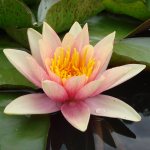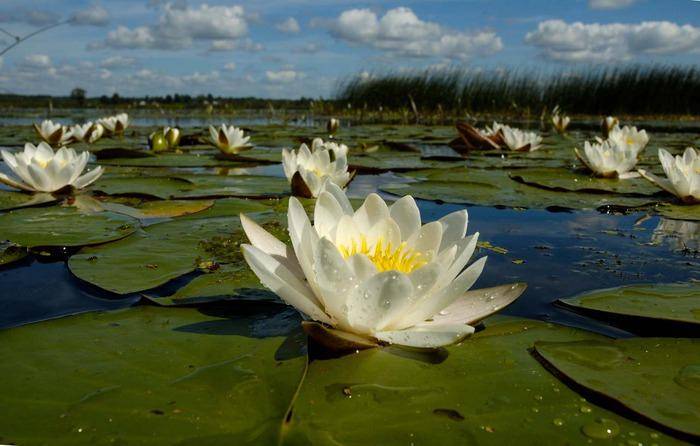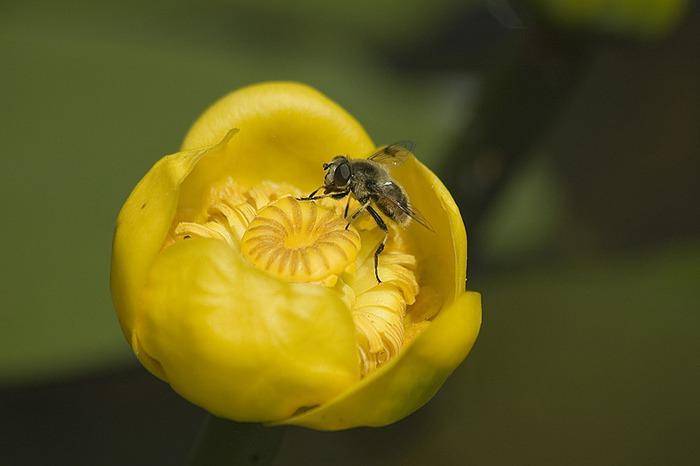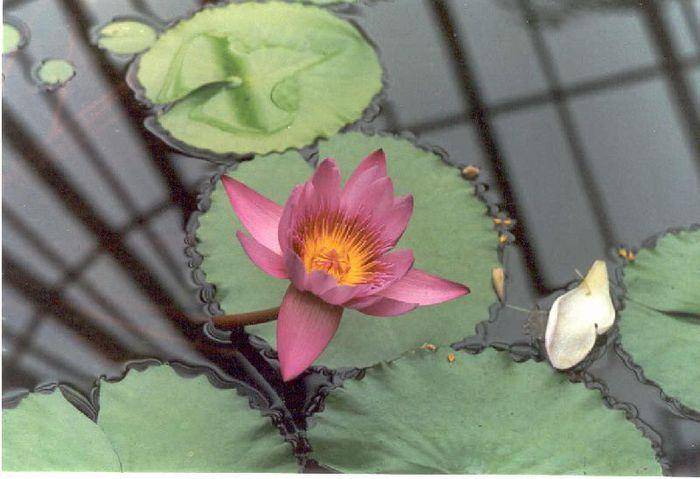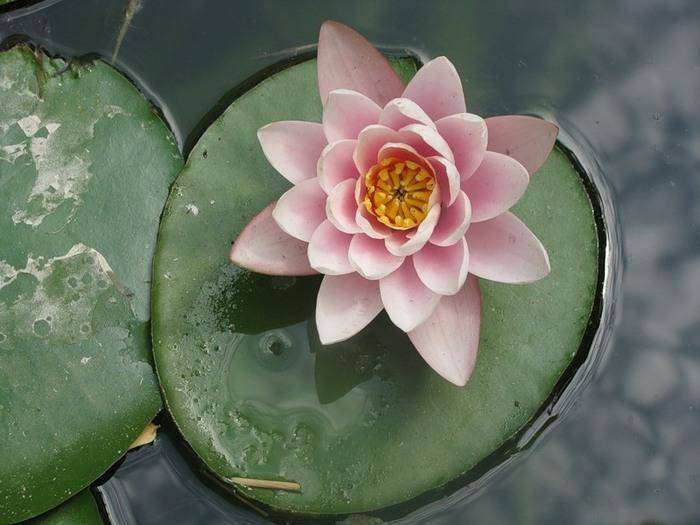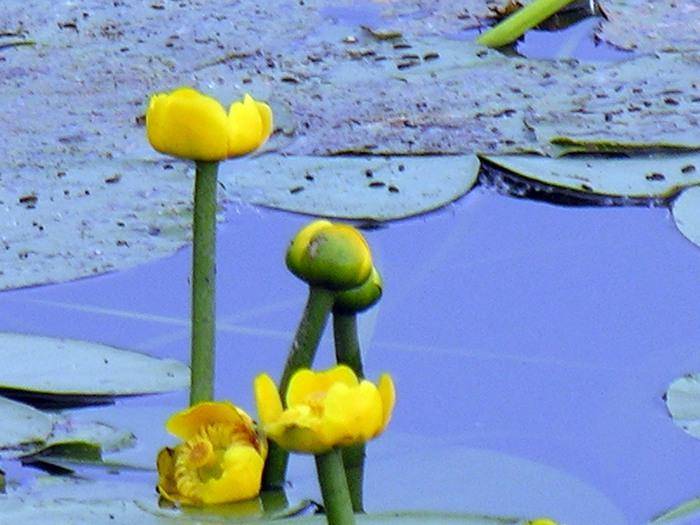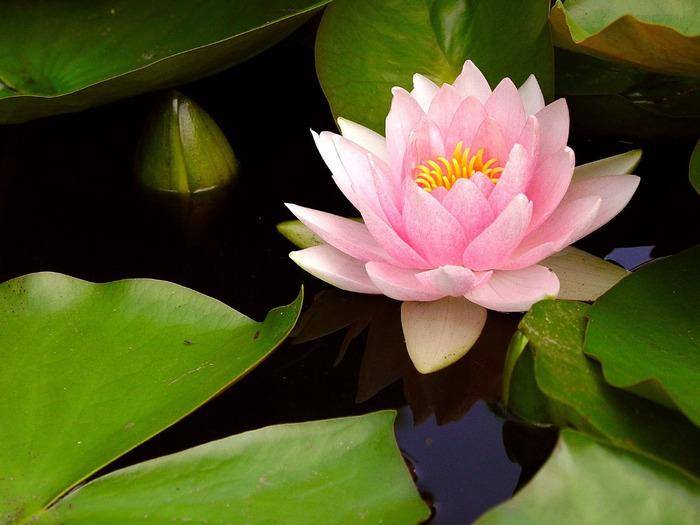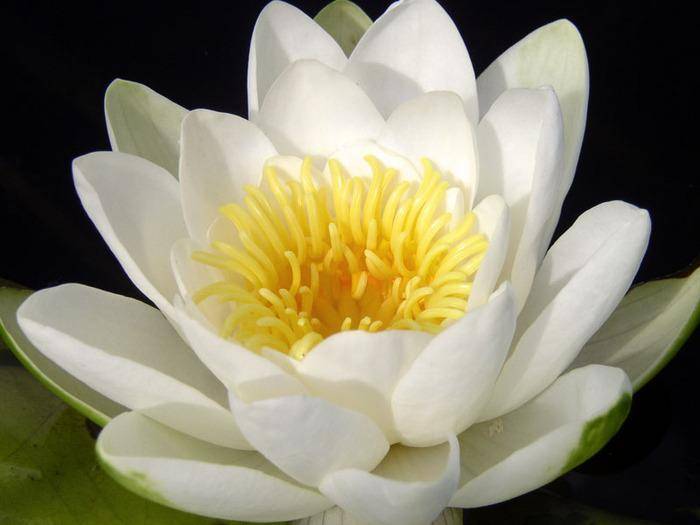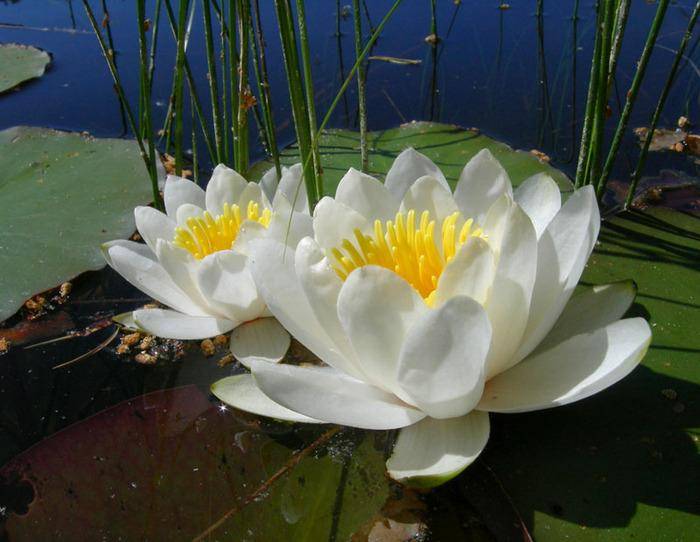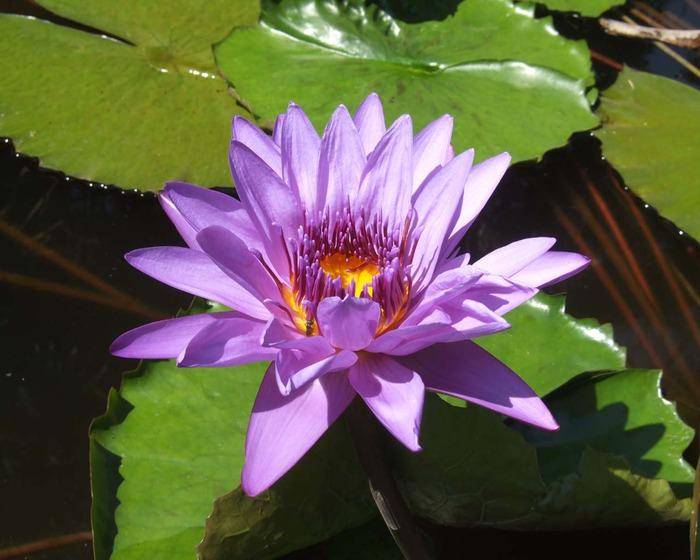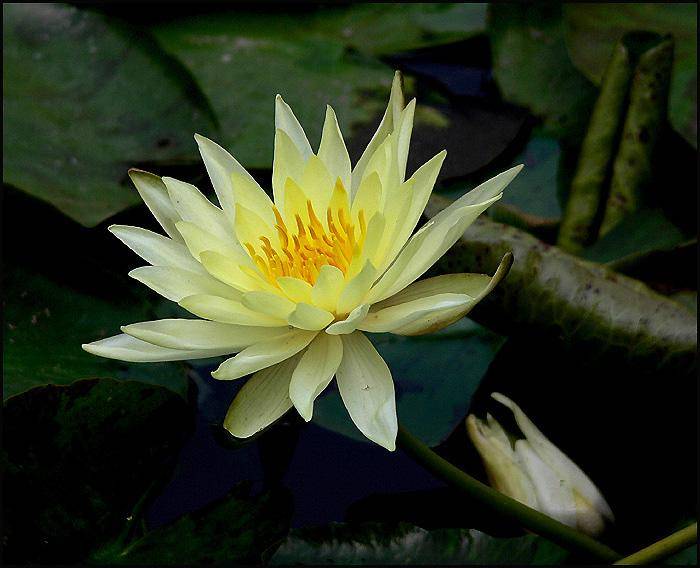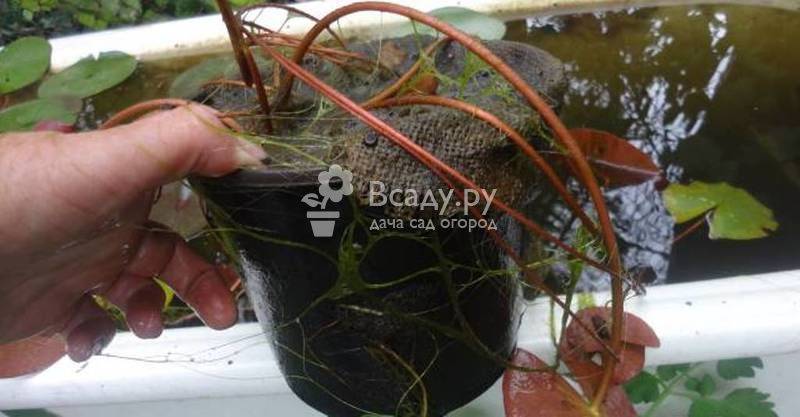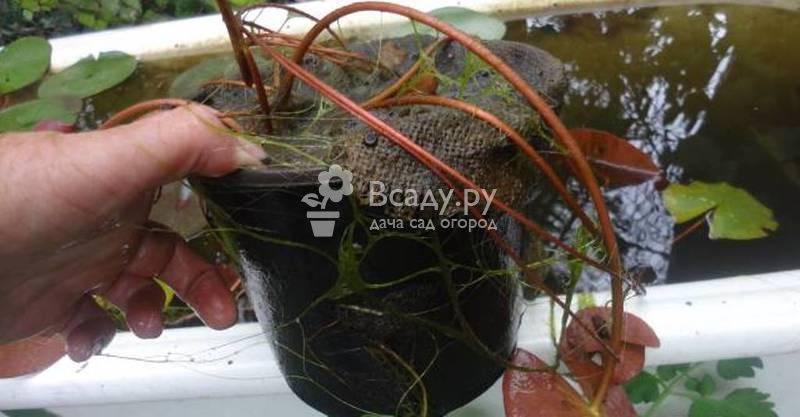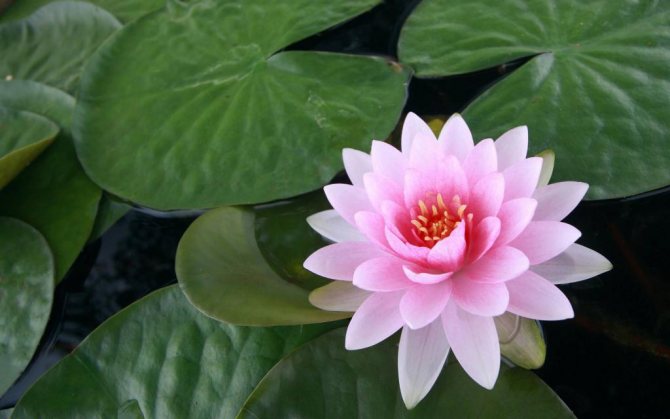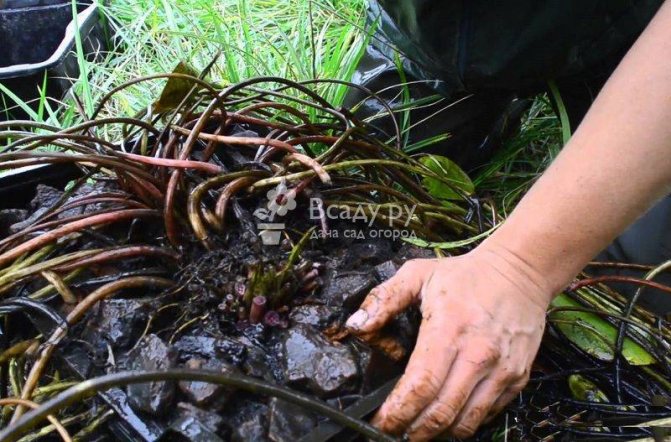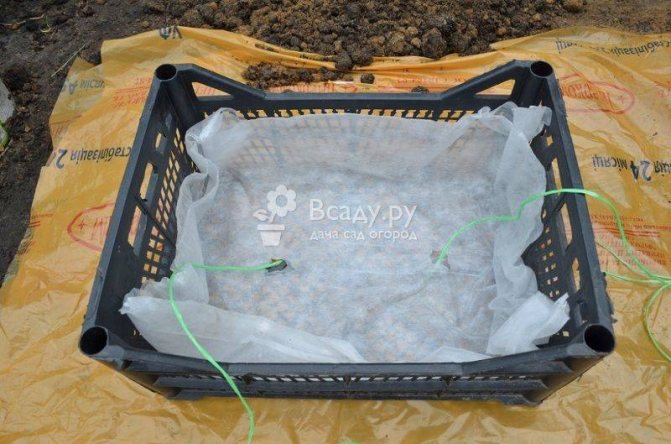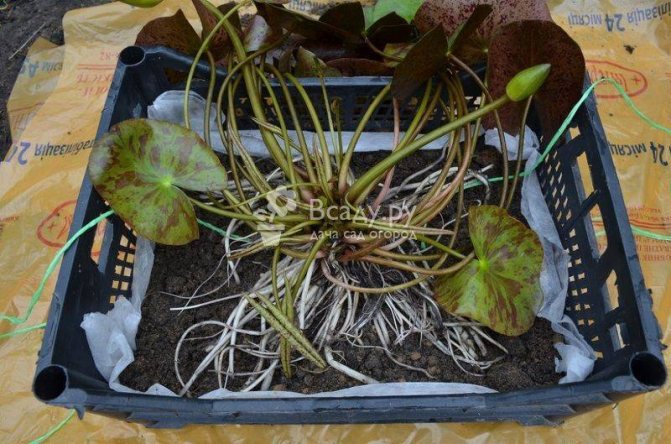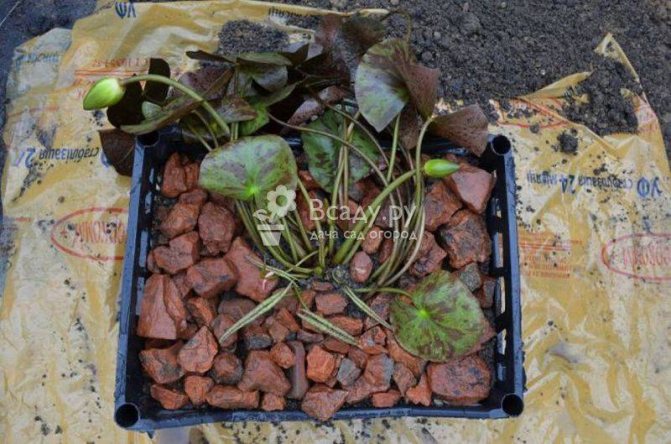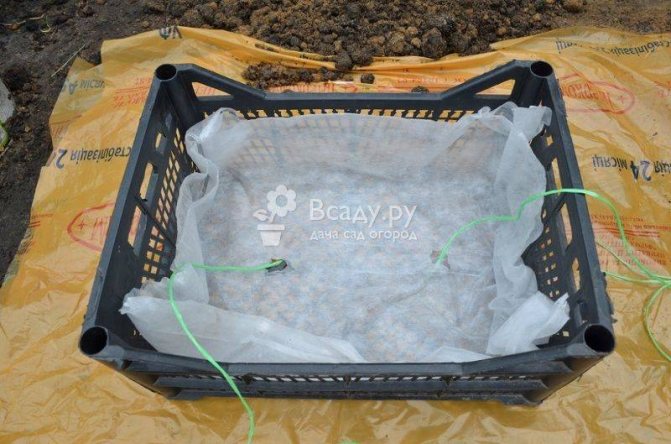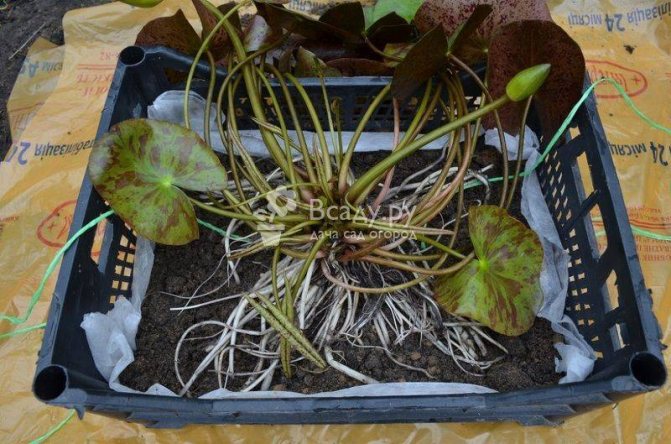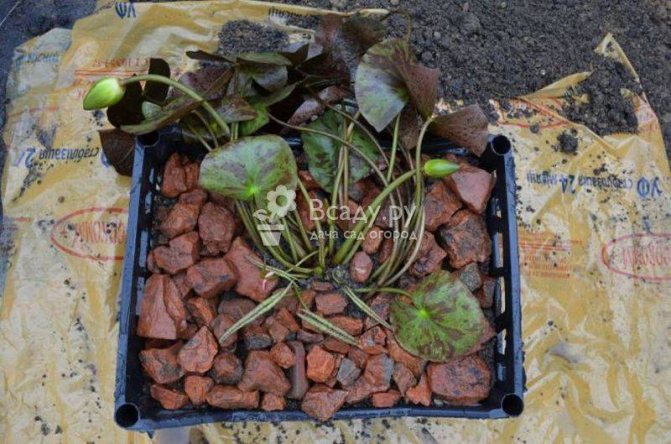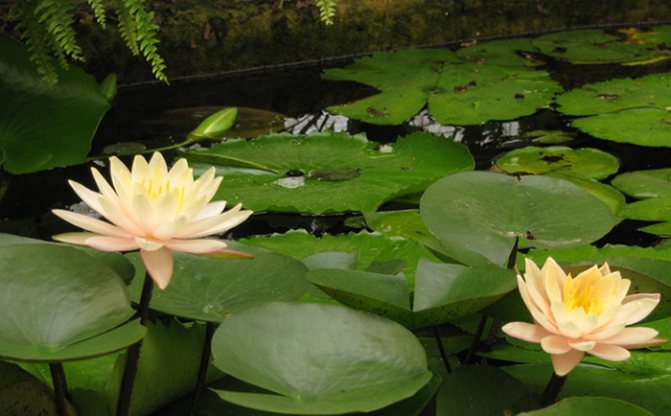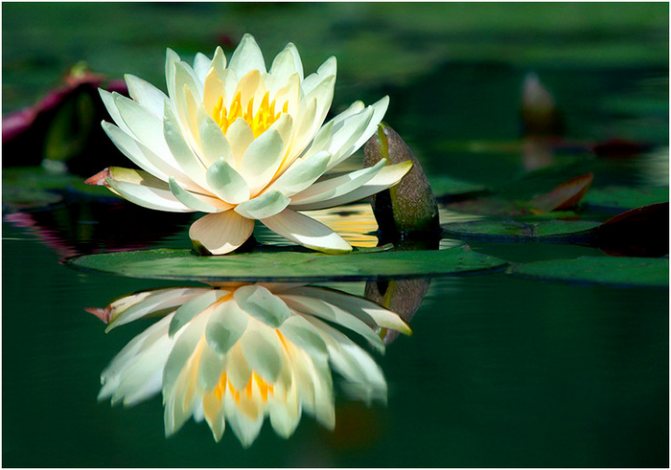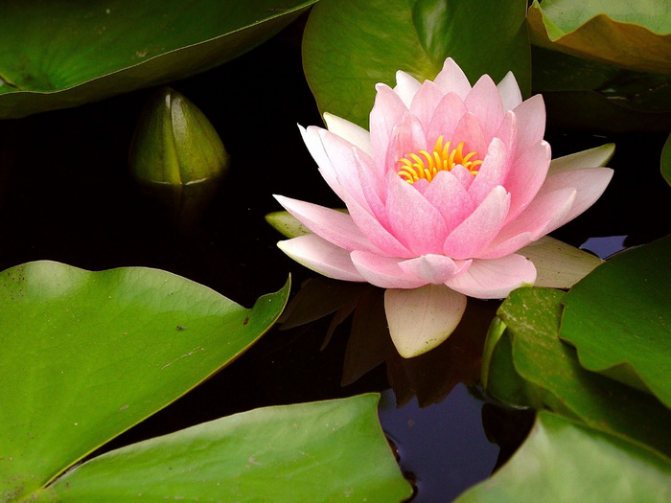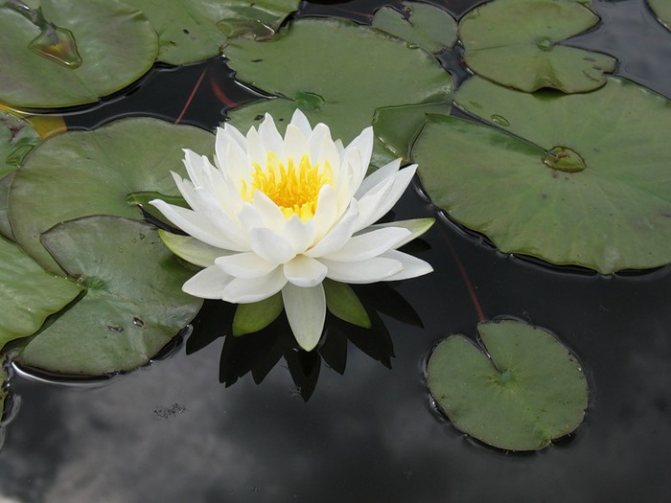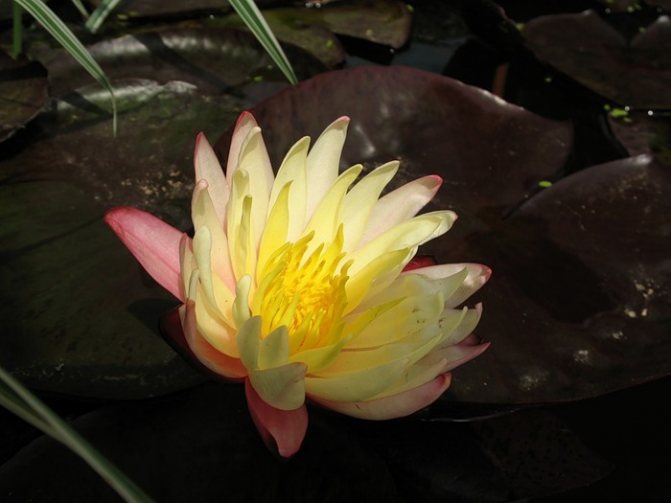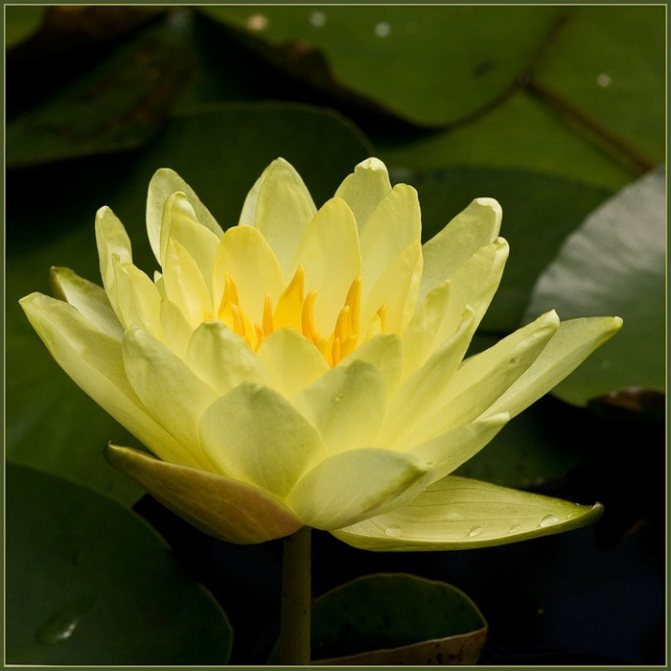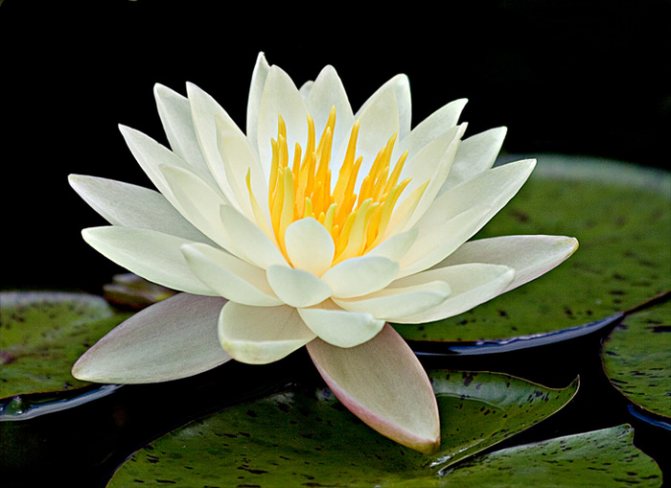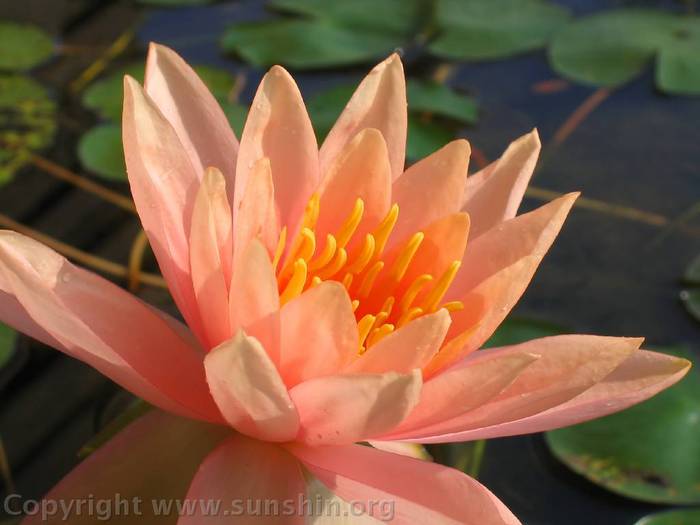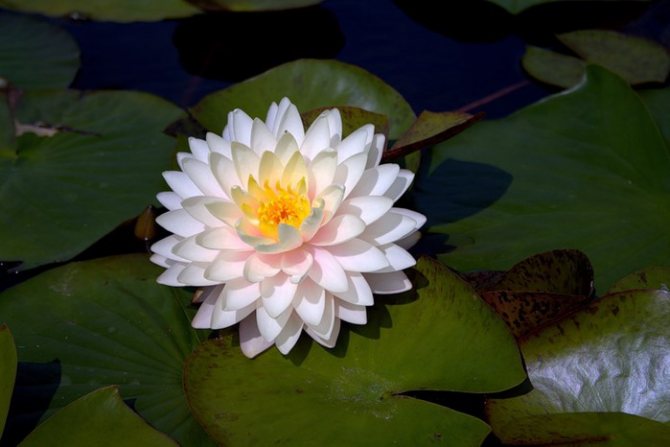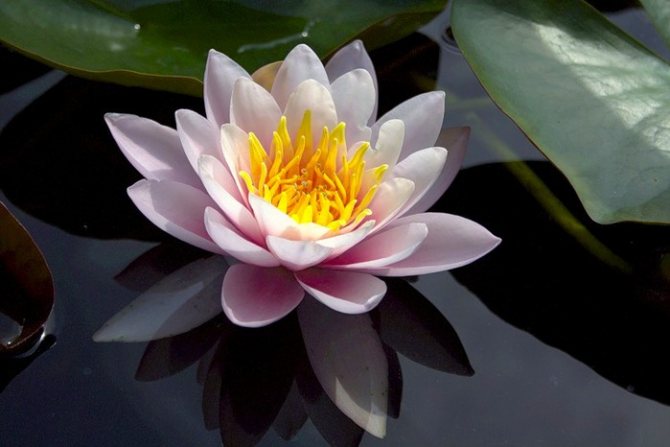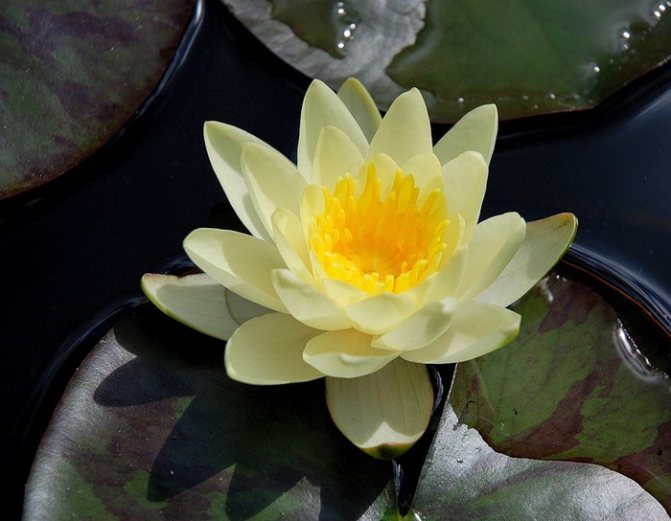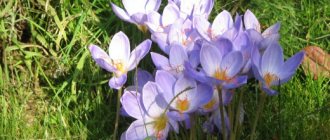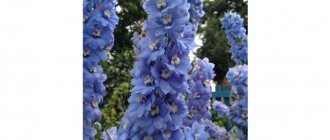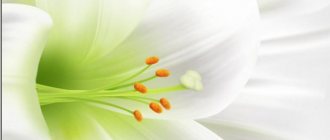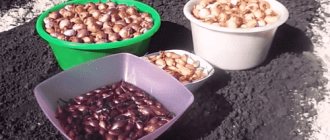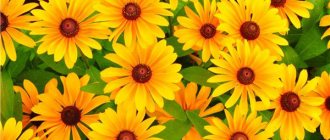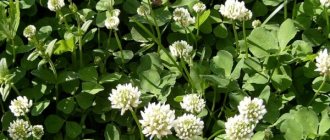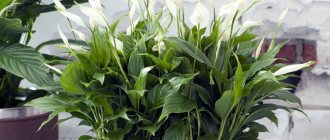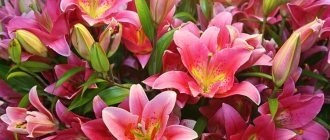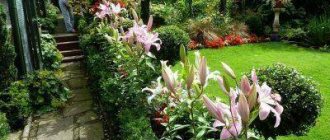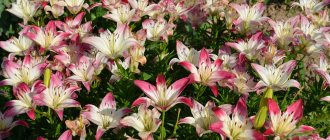Water lily
(lat.
Nymphaéa
) Is a genus of aquatic plants of the Waterlily family (
Nymphaeaceae
), which includes about 50 species. A well-known plant with large, heart-shaped-oval or heart-shaped-rounded leaves floating on the water, rounded, up to 30 cm in diameter, and large flowers, as if floating on the water, change color with age, from white, reddish to dark green and reddish -violet. It has single large flowers, up to 20 cm in diameter. The calyx, consisting of 3-5 petals, has a strong delicate odor. Blooms throughout the summer. Fruits are green, spherical, ripen under water.
By the depth of immersion and the diameter of the leaves, the species of water lilies are very different - from mini-plants to giant plants. There are about 50 species of these plants. The most common species are white, snow-white, tetrahedral, tuberous, fragrant, dwarf, hybrid, blue, brindle. It grows in the European part of Russia, western and eastern parts of Siberia, Transcaucasia and Central Asia. Most often it can be found in the forest zone and in the steppes. In addition, the water lily is used for decorative purposes in landscape design. White water lily can exist in standing and flowing water bodies, prefers sunny places.
Other name - overcome the grass, pupa, egg capsule, mermaid grass, underwater bread. Often called a water lily yellow capsule, and the white water lily is called water lily... Also, a water lily is often confused with a lotus, but this is a completely different plant (see photo below).
Water lilies form thick creeping rhizomes rich in starch under water at the bottom. These rhizomes can be raw materials for making flour and starch. Tannins are removed from them by soaking cut rhizomes or flour obtained from them in water. Toasted water lily seeds can serve as a substitute for coffee.
Water lily
Water lily and water lily are one and the same plant. The flower is widespread in fresh water bodies of forest and steppe territories of Europe, Siberia (Eastern and Southern), Central Asia. They are also called lotuses. Sometimes the Chinese swimsuit is mistakenly called the golden lotus - these two plants have similar flowers, but they belong to different families.
People from the tropics do not react well to cold (temperatures below 0 degrees) and lack of sunlight. But through the efforts of breeders, hybrids that are resistant to frost have been bred. Popular frost-resistant varieties of lilies are:
- Alba;
- Marliak Korney;
- Black Princess.
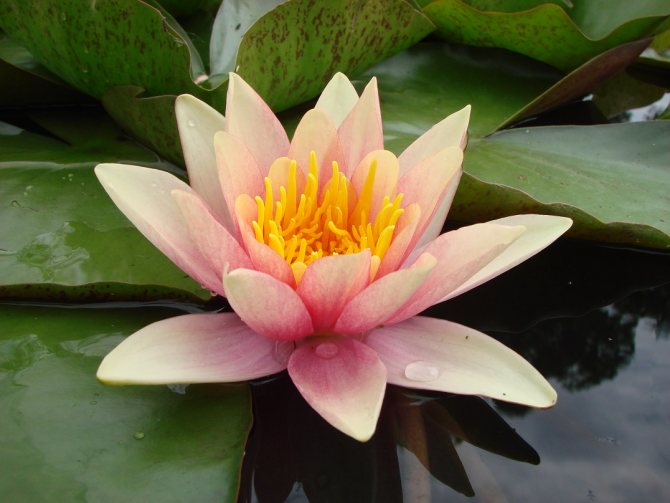
Water lily
The water lily is often bred in artificial ponds in private plots. Water lily (water lily) belongs to the Kuvshinkov family, the Water lily genus. There are more than 50 species of them in the world.
Popularly, the water lily has the following names: overpower white, mermaid color, water poppy, beaver, white chickens, water companion, water color.
Interesting! The water lily is called "the sun child", as its buds open together at sunrise and close in the evening when the sun hides behind the horizon.
Eating
The high content of edible starch makes the rhizome of the plant edible.True, it also contains tannins, which must be removed from the product by soaking. Cakes are baked from dried and crushed roots. Boiled roots are also fried for a side dish. The largest amount of starch is found in plants in the fall.
The seeds of the culture are also edible. In addition to starch, they contain oil. The seeds are fried and chopped. A drink like coffee or chicory is prepared from ground seeds; it is also added to sauces as a spice.
Medical use
This plant has found applications in medicine and pharmaceuticals. Water lily root tincture is used as a sedative, pain reliever. A decoction of the roots helps with skin rashes, diseases of the respiratory organs and spleen.
In ancient times, healers used decoctions and infusions of water lilies to stop internal and external bleeding. In folk medicine, the roots of the plant are used to fight fungal and bacterial diseases. Fresh leaves, wrapped in gauze in a crushed form, are applied to burns and abscesses.
Note! With great care, a decoction from the plant should be taken by people who have low blood pressure, since the remedy itself is very capable of lowering it.
Myths and legends
Folk beliefs attribute magical properties to the plant, calling it "overpower-grass", mermaid color. It was believed that the water lily protects, helps to defeat the enemy, but if the thoughts of the person using it are black, the magic will be turned against him.


Scandinavian legends tell that each water lily has its own elf friend, who lives exactly as long as a beautiful plant.
Characteristic features of culture
Lily-tree
The water lily "dwells" in ponds, rivers and freshwater lakes (where the flow is smallest), has a very strong, wide, densely intertwined root system, which firmly adheres to the bottom soil. The roots reach a height of 2.5-3 m. Thanks to such an air system, even a river lily floats freely on the water, in spite of the current, downpours and wind.
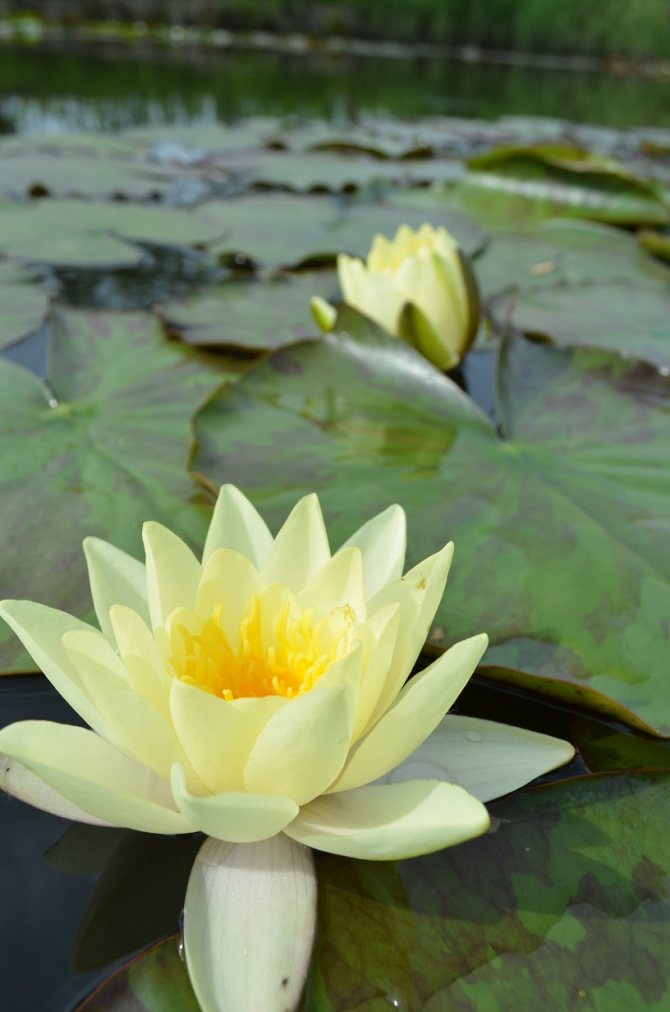

Yellow water lily
The egg-shaped leaves of the water lily have a dense glossy structure. In a young plant, they are pink; during the growing season, they change their shade to marsh green.
Water lily flowers are large (about 30 cm in diameter), single. Different types of petals have different colors (white, cream, yellow, purple, blue). The aroma is intense, sweetish. The plant blooms from June to October. Water lily is an insect pollinated crop.
Color spectrum
The color of the water lily plant is diverse. In addition to the snow-white colors familiar to us, you can find the following color options:
- Blue.
- Purple.
- Lilac.
- Creamy.
- Pink.
- Yellow.
- Red.
Bright colors are inherent in those plants that grow in the warmer corners of the planet, a more modest design is inherent in water lilies - residents of Russia.
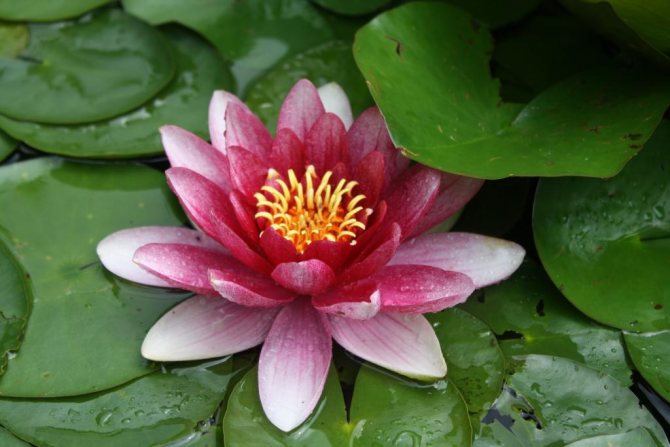

Description of water lily species
Asian lily: planting and care in the open field
Of the many types, some are the most common. These flowers are unpretentious and very decorative.
Yellow water lily
One of the varieties of water lilies is the yellow capsule. The plant has rather fleshy, cylindrical roots that are rich in starch, alkaloids, tannins, phytosterols, sucrose, ascorbic acid. They cling to the bottom soil with cord-like roots. In addition to the emergent leaf, the egg capsule is also provided with underwater leaves, which differ from the former in structure (folded, transparent).
The flowers are pods 5 cm in diameter, five-petal, greenish at the base and bright yellow at the top. The plant blooms from July to October.The fruits are green slimy, which allows some of them to stay on the water surface and travel long distances.
Lily pink
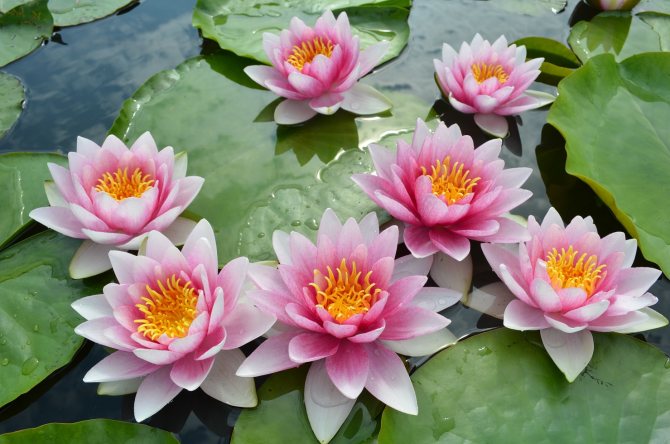

Lily pink
The fragrant (pink) lake lily grows in the lakes of North America. The depth of flower germination is 40-80 cm. The diameter of the buds is about 15 cm. The flowers exude a sugary sweet smell.
White water lily
White water lily (nymphaea alba) is the most common species. It is also called a white water lily or white nymph. It is grown both as a beautiful decorative flower, and for the manufacture of medicinal products, and for food use.
The roots of the plant are up to 3 m long. The stems are erect. The leaves are solitary, emerald-colored, shaped like a heart, up to 35 cm in diameter. The flowers are large (20 cm in diameter), snow-white, and the stamens at the buds are bright yellow. Flowers open only in clear sunny weather. Flowering is observed from the second half of July to the end of August. The aroma of a white water lily is delicate, light. The jug-shaped green fruits ripen in early autumn.
Reproduction of a white lily is possible by seeds and dividing the bush. Unlike other varieties, this type of water lily is listed in the Red Book in almost all regions of Russia.
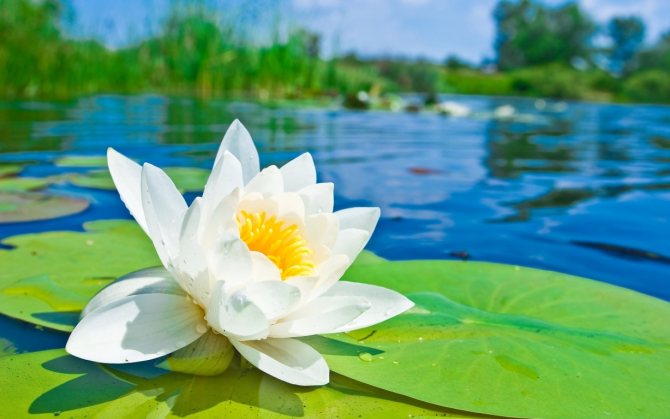

White water lily
Nymphaea water lily (nymphaéa)
This type of water lily is grown at home, in indoor aquariums. The birthplace of the flower is the swamps of West Africa (swamp lily). It is distinguished by dark purple spots on the plate of the heart-shaped leaf. The flowers are white and pink.
Home cultivars
In nature, pitchers are represented by numerous varieties, but not all are domesticated. There are several recommended representatives of Flycatchers for growing at home:
- Winged. It grows up to 90 cm, the leaves are dark green, the traps are salad green with a red tint or speck.
- Jug. A distinctive feature is that the traps are grouped into nests.
- Reflezi. With large leaves (50x10), jugs 20 cm long, light green, with red stripes and spots, bluish inside.
- Madagascar. It grows up to 1 m, leaves are bright green, jugs up to 25 cm, bright crimson.
- Double spur. With large foliage up to 60 cm and mini jugs (10 cm).
- Hookerian. The traps are light purple.
- Bloody Mary. Grows large burgundy jugs.
- Pitched. It is able to digest even small rodents.
- White-bordered. With cream and pale pink traps 15 cm long.
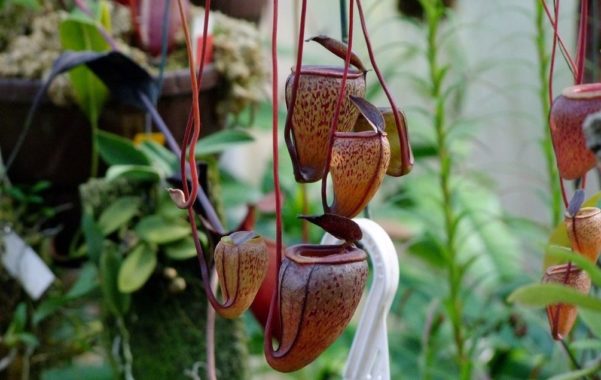

You can also grow Nepentes Pervilla, Hairy, Truncated, Attenborough and some other varieties at home.
Breeding and planting care
Lily Regale
Reproduction and care of the lily occurs in the spring and summer. In winter, the flower sleeps and you do not need to care for it.
The awakening begins in April. Young twigs (pagons) of light green color sprout from the rhizome. By early summer, they reach the surface of the water and form leaves and buds. The flower lives for about 5 days, then withers and sinks to the bottom. Further, seeds ripen in the bud and are sown on the bottom soil or float to the surface and spread over the nearby territory (in nature, this method of reproduction is ineffective).
Reproduction in artificial conditions
Typically, water lilies reproduce by sprouting side shoots. How many new shoots there will be depends on the age of the water lily.
Florists usually breed the plant with seeds. The process of planting seeds is carried out in this way:
- sand is poured onto the bottom of a shallow container and seeds are sown, the plantings are heavily flooded with water (2-3 cm above the ground);
- 5-7 days after germination, the seedlings are seated at a distance of 2 cm from each other;
- after 3-4 days, the distance between the seedlings is increased to 3 cm;
- a few days later, young plants are planted in separate containers and sink to the bottom of the reservoir, the water in which must be warm (not lower than +22 degrees);
- after 7-10 days, you can plant seedlings in permanent pots.
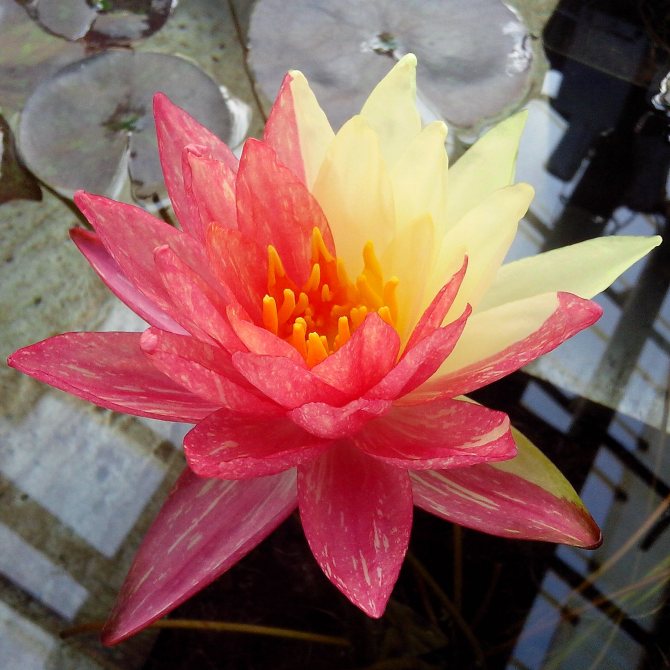

Water lily nymphea
Care
When caring for water lilies, it is important to follow some rules:
- feeding with bone meal, compost or special additives for domestic underwater plants;
- providing non-freezing depth of the pond or storage in a warm room;
- compulsory fish breeding.
At temperatures below 15-17 degrees, the culture must be transferred to heat.
In order to detect a disease or pest infestation in time, the water lily must be regularly carefully examined. When small insects appear on the organs of the plant, change in color or appear spots on the leaves and buds, it is necessary to determine the cause and take appropriate measures.
Important! In order not to harm the flora in the reservoir, chemical preparations cannot be used in the treatment of flower diseases. Only folk remedies are allowed.
Outcome
A water lily can be a decoration for your pond: care, cultivation, and frost protection are all you need to grow magnificent plants. Having carefully prepared the soil and containers, and having mastered the simple rules of division, you will be able to propagate lilies on your own, turning the garden pond into a fabulous meadow of flowering water lilies.
This plant is called a water lily by the shape of the ovary. Well, with the word lily in the title, everything is extremely simple: this word has become collective and means "beautiful flower".
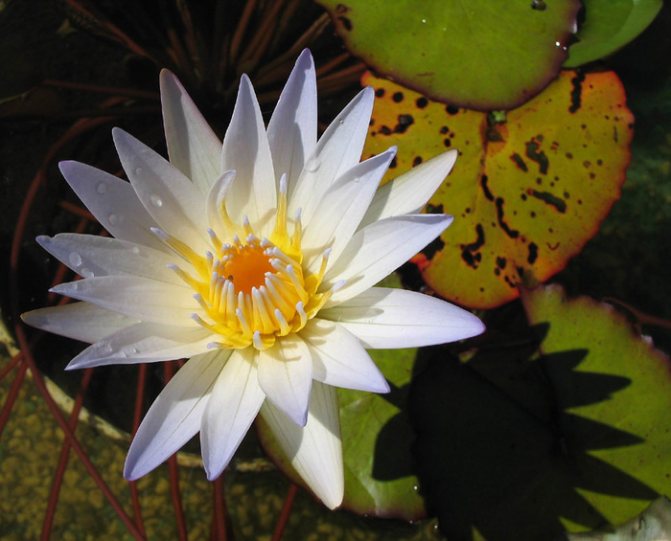

According to the ancient myth, a nymph (i.e. a Greek mermaid), who died from unrequited love for Hercules, turned into a white water lily (is it not from there that the belief that a flower helps reciprocity of feelings?). The Greeks considered the water lily a symbol of beauty and eloquence; girls decorated their heads and tunics with garlands of them. Elena the Beautiful also had such a wreath at the wedding with Menelaus, and the entrance to the newlyweds' bedroom was decorated with water lilies
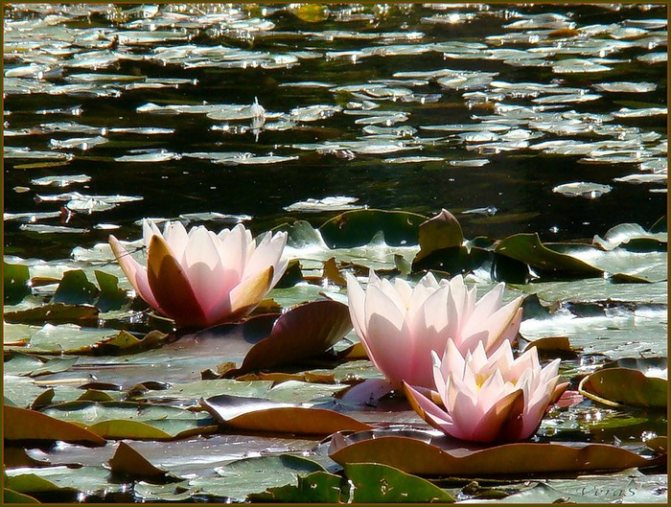

The Italian legend is even sadder. The swamp king set out to achieve a marriage with the beautiful Melinda, and once, when she admired the yellow egg pods (the Romans for some reason called her a symbol of treason and treachery), he turned into a stump from which one could reach the flower he liked, and then went under the water with the beauty. And where it happened, white flowers with a yellow core appeared on the water.
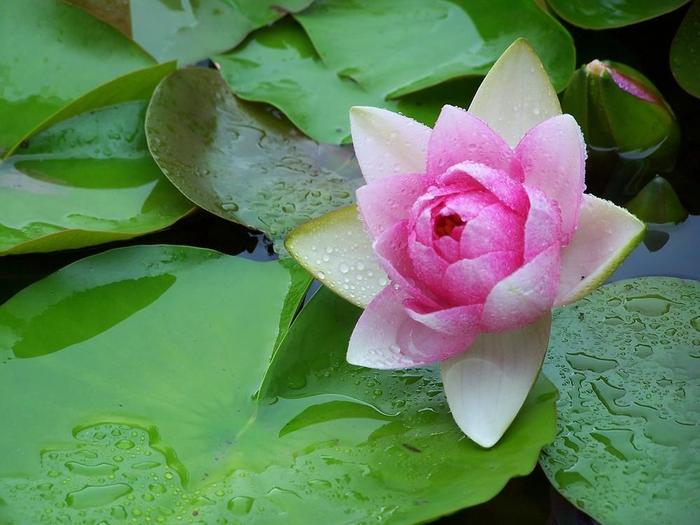

The Scandinavians, of course, could not do without elves. Their ancient legends claim that they sleep in the depths of a flower during the day, and at night, swinging a pistil like a bell tongue, call their fellows for a conversation and ride on the water in water lily boats


The North American Indians laid down a legend about how two stars claimed an arrow shot into the sky by a dying great leader. They dashed after her, and sparks fell from the sharp blow. Falling down, they fell into the water and turned into white water lilies - lilies
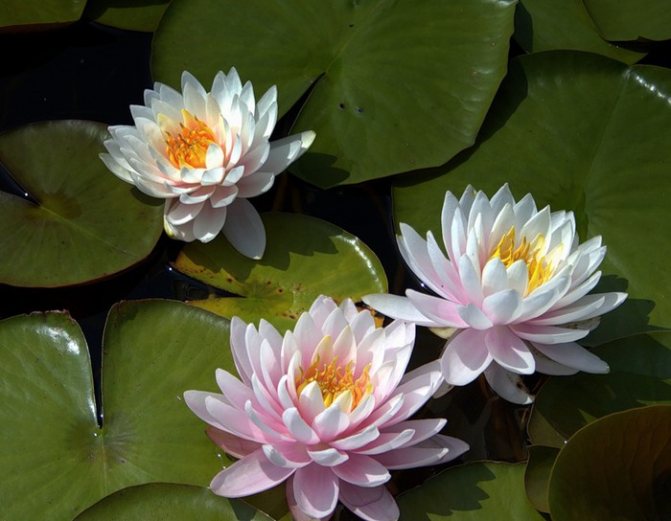

From time immemorial, this flower has been an object of worship and adoration among the North-West Germans. They called the white water lily a swan flower and revered it so much that they even depicted 7 flowers in their coat of arms. These flowers are also depicted on the Frisian banner and the coat of arms of the German province of Groningen.
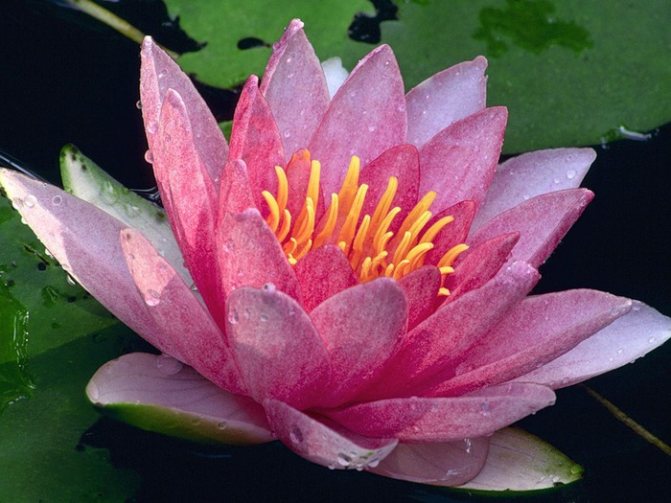

However, in ancient Germany, this flower was not only revered, but also a little feared. Legends tell that in ponds and lakes, among the flowers of water lilies, nyxes live - beauties with very cute and friendly faces and fish tails. They lure people into the water and then drag them to the bottom. In the Black Forest, in Germany, there is even a lake named after Mummelsee - from the old German die Mumme - nymph. The lake, allegedly, is simply flooded with these creatures ...
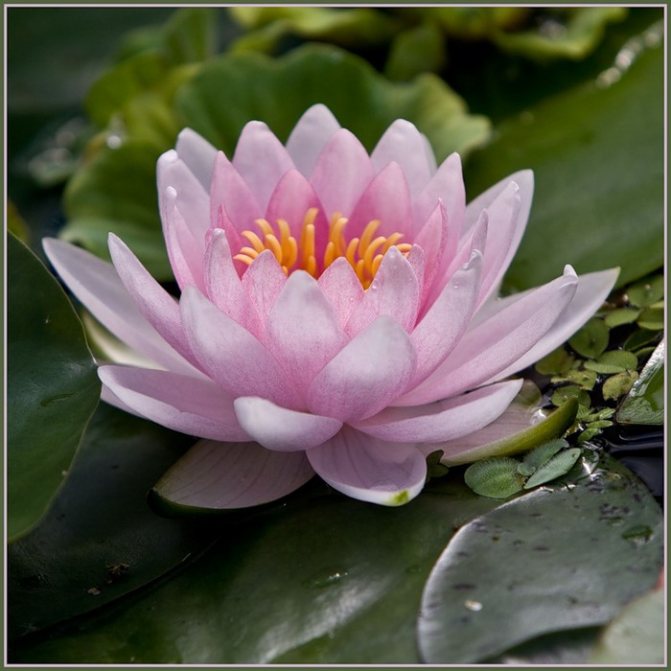

In Slavic mythology, nymphs and nyx were replaced by mermaids - water beauties with a pale, beautiful face, a slender figure and a scythe below the knees. Mermaids, like nyxes, also love water lilies and even sometimes turn into them, so the white water lily is often called the "mermaid" flower.
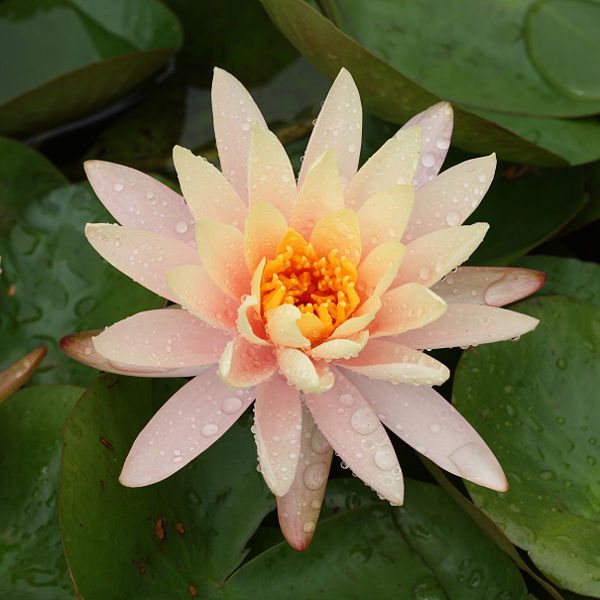

And the week following Trinity Day was popularly called “Rusal” by the people. There is a belief that it was at this time and a little earlier - in the Orthodox calendar on the seventh (Trinity-Semitic) and eighth (the same, "Rusal") week after Easter, mermaids most often go ashore. At midnight, in the light of the moon, they dance in circles, and sometimes they climb trees and laugh, attracting the attention of young boys and girls. And they will tickle to death and drown them to be unkind to those who succumb to their charms. You can protect yourself from the attack of mermaids with the help of a talisman made of wormwood or lovage (dawn grass).
But not only the mermaids carried danger.There was a belief that where these water charms frolic, the grass grows thicker, the bread ripens better. This is how the ritual of seeing off mermaids from the village to the field arose. The girl, dressed as a mermaid, was led by a crowded procession outside the outskirts, there she was pushed into the field, after which they quickly fled to the village. Over time, this rite turned into one of the many fun of Semik and the Russian week - chasing mermaids.
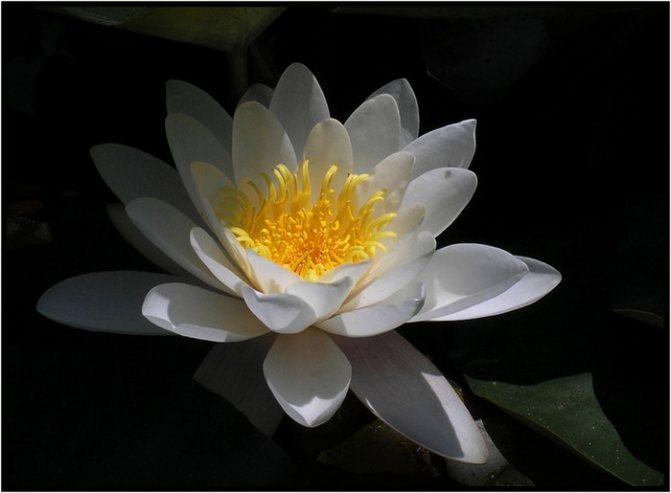

Another mention of the water lily in Russian folklore - it was this plant that was called the famous "overpower-grass". The rhizome, hung in the house, protected from various misfortunes, and carried with itself as a talisman, helped to overcome various life difficulties. Overcome grass was advised to stock up before childbirth, before a responsible date or going to litigation.
As is known from Greek mythology, nymphs are deities of nature: forests, mountains, lakes, rivers and seas. Unsurprisingly, flowers named after them are beautiful. The genus water lily, or nymphea, includes about 50 species of herbaceous aquatic perennials with fleshy rhizomes. The leaves of the nymphs are round or heart-shaped, with a deep cut at the base, floating on the surface of the water.
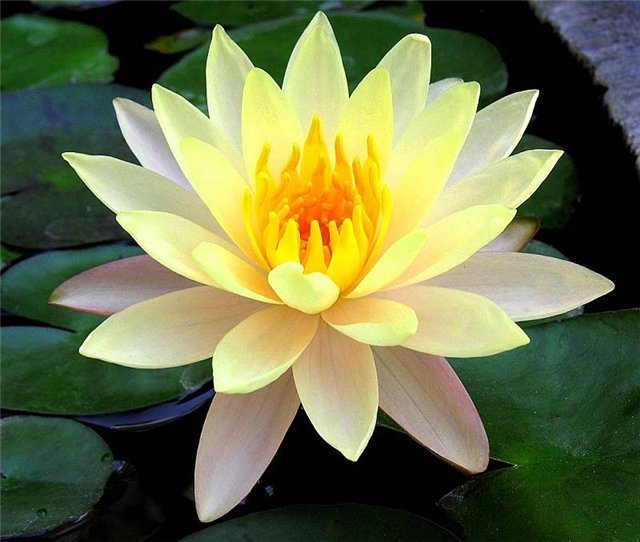

The flowers are large, surprisingly beautiful, star-shaped or cupped. They can be of all kinds of colors - white, cream, dazzling yellow, orange, pink, dark red and even blue. There are varieties with simple, semi-double and double flowers. Some of the water lilies open during the day, others at night. Some have a pleasant aroma. Berry-like fruits ripen under water.
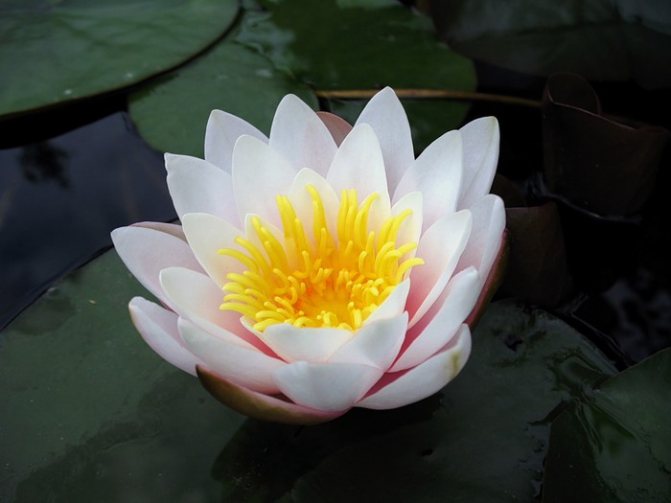

In very swampy places, the rhizomes of some water lilies, and in particular, white water lilies, sometimes intertwine so strongly that they form "islands" on which you can even walk, they are so strong. In the rhizome of the water lily, as in other parts of the plant, there is a complex system of airways that can be seen even with the naked eye. These channels provide not only the respiration of the plant, but also help the leaves to stay in the water column and on its surface.
Water lilies bloom in northern reservoirs usually in June, but the maximum number of flowers can be observed in August. In the southern regions, water lilies bloom in May. Their flowers rise out of the water and bloom in the morning hours, and in the evening they close and go back under the water. If the weather is cloudy, then the water lilies do not rise from their water bed.
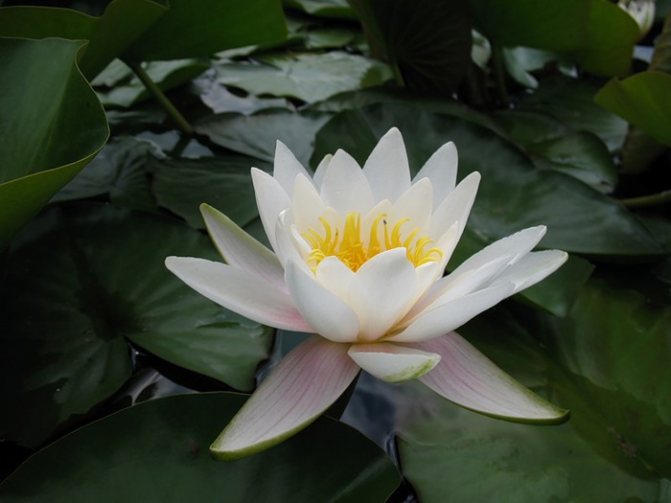

Planting a water lily
The seedlings are planted in a low but wide container. Drainage holes are drilled at the bottom of the pan. As a soil, just coarse sand or garden soil is suitable. It is not recommended to use peat - there is a high probability of algae reproduction. So that the soil does not wash out, it is advisable to put burlap on the bottom of the pot.
Pick-up location
For successful growth, a culture needs the following conditions:
- lack of flow;
- pond depth 20-30 cm;
- silty bottom soil;
- illuminated area.
In deep freezing water bodies, bushes in pots should be planted (for ease of transfer to winter in warmth), in small ones they can be planted directly into the bottom soil.
Note! After planting, flowers will appear only after three years.
Plant transplant
So that a plant that grows in a small container does not lose its decorative effect, every 2-3 years the flower is transplanted into a larger pot. The transplant is carried out by the method of transshipment of the rhizomes together with a lump of earth. If the rhizome is bulky, then it can be divided (cut with a sharp knife into pieces with 2-4 living buds) and separate bushes can be grown from the pieces.
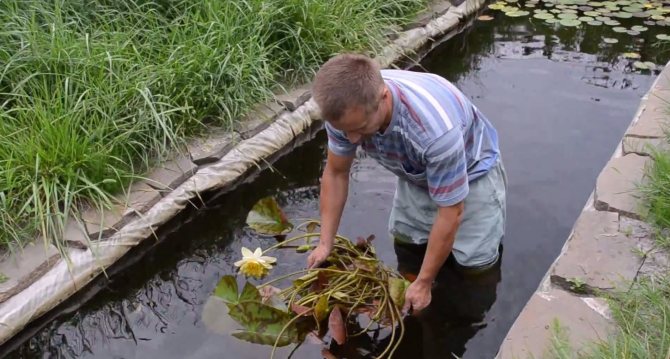

Planting a water lily
Conditions for flowering lilies
The culture is very demanding on lighting. When constructing an artificial reservoir, this must be taken into account. If the plant does not have enough light, you can not wait for flowering.
Beautiful pond decoration
There is a beautiful legend about green tea and a white water lily... If at dawn green tea is placed in a blossoming flower and collected at the end of the day, then after drinking it, a person will gain the necessary vitality.
If a water lily has settled in your pond, then an interesting solution would be the appearance of fish in it. Fish not only decorate the pond, but also serve as good helpers for flowers.
The most popular fish will be Koi carp and comets. They are extraordinarily beautiful. Comets are more mobile and live in the upper layers of the reservoir, moreover, they do not bother flowers. And carps are more fussy, rushing about in plants and making a mess.
If the reservoir is large (2-3 meters deep), then carps will fit better into the picture. If the reservoir is small (up to 70 centimeters), then opt for a comet.
Pest and disease control
For the successful cultivation of water lilies, it is necessary to protect the plantings from diseases and harmful insects. She is often defeated:
- aphids (an infusion of horsetail in a dosage of 500 g per 5 liters of water, agravertine, phytoferms will help);
- leaf beetle (you should collect insects by hand and immerse the whole flower in water);
- marsh moth (should be hooked into a pond of a water spider);
- leaf spot (you will have to process the planting with Bordeaux liquid);
- black root rot (the plant should be destroyed).
Experienced growers recommend planting plants next to the pond that are suitable for the colors and breeding conditions. Various types of violets are considered moisture-loving. Red water lilies with orange flowers look wonderful, scarlet ones with lilac flowers, creamy yellowish ones harmonize with white ones.
Growing water lilies is available even for beginners. This requires only a suitable reservoir, the plant itself and adherence to the rules of planting and care. The variety of species of lilies in the pond will help create original compositions.
Interesting Facts
We offer you to get acquainted with a selection of interesting facts about water lilies:
- Sometimes these plants are confused with sea lilies, which also resemble a water lily, but science has proven that the latter do not belong to the plant world, representing primitive animals.
- In the leaf of a water lily, a water lily, there is a large amount of air located in special cavities. Therefore, it does not immerse itself in water if something overweight, such as a bird, is placed on it.
- The plant has a pleasant aroma that attracts insects for pollination. Sometimes the beetles trapped inside the flower are forced to spend the night in it, because after sunset the water lily closes. In the morning, insects get out of the flower captivity.
- It is considered an amphibian - after drying out of its native reservoir, it is able to survive on land.
Water lilies are indicators of the ecological situation in the reservoir - if their number is sharply reduced, then the lake or pond is polluted.
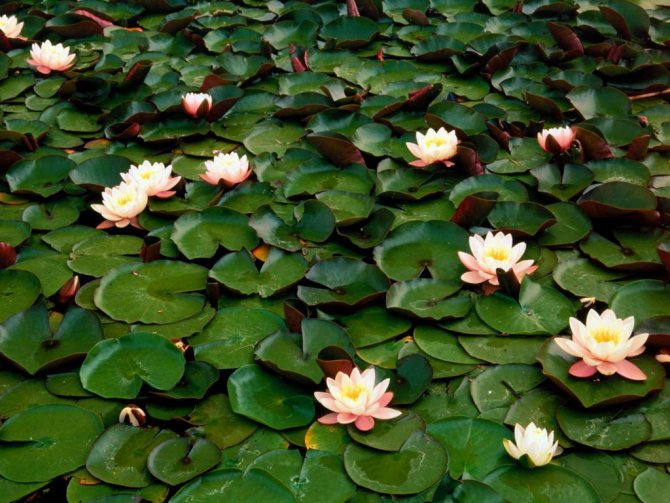

Medicinal properties and harm
In addition to its decorative qualities, the water lily has medicinal properties. The root of the plant helps with hair loss, treats constipation, gastritis, enuresis. Freckles will go away after regularly rubbing the problem areas with water lily juice. Pharmacology uses various constituents of the plant:
- as part of the collection of Zdrenko for the treatment of oncology and gastrointestinal ulcers;
- for the manufacture of drugs that stimulate cardiac activity;
- to combat staphylococcus and salmonellosis;
- in psychotropic drugs;
- to regulate blood pressure.
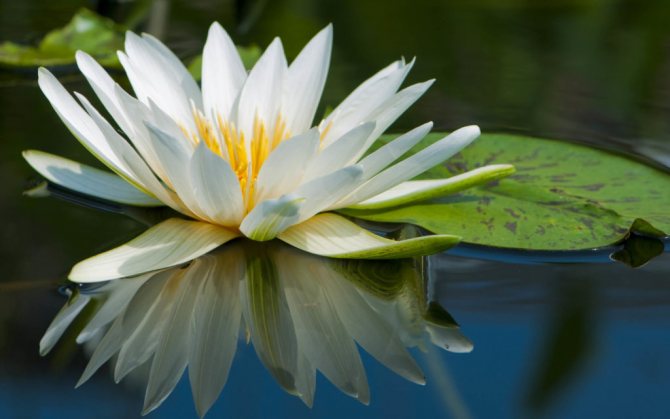

Water lily has medicinal properties
Traditional medicine widely uses water lily flowers at elevated temperatures, insomnia and nervous diseases, diseases of the genitourinary system.
When using medicines and decoctions based on water lily, you need to remember that the plant is poisonous. It is necessary to consult a doctor before admission and observation during treatment.Contraindication is pregnancy and breastfeeding.
How to propagate a plant
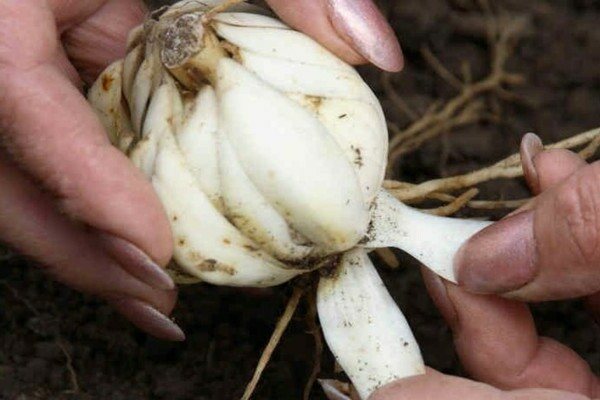

Marsh lily: photo of the bulb
After the pollination period, the plant sinks into the water, where berry-like fruits with a large number of seeds ripen.
After the fruit berry bursts, the seed floats on the surface of the reservoir. Some seeds are transported on their own through the water, while others sink to the bottom and germinate.
Gardeners rarely use seed propagation, most often the marsh lily is propagated roots.
For reproduction, the roots are cut off from the flower, in which the buds are in a dormant state. In the place of the cut, ground charcoal or ash is poured.
You need to divide the plant very quickly. Since foliage and root system do not tolerate terrestrial environment well. To make it easier to move the water lily from place to place, you need to use a container of purified water.
Water lily, description of the plant


The nymphea flower is a perennial aquatic plant with a long stem and a well-developed root system, hidden under a layer of silt and water. Water lilies stay on the water due to powerful root shoots with which the plant clings to the ground and wide floating leaves.
In the nodes of a long, strong stem, buds are located, from which large leaves develop during the growing season, some of which can be in the water, revealing only the upper and largest green "plates" to the eye. The size of the leaf varies from 25 to 35 cm, the plate is dense, dark green in color.
200-125 training is the ultimate preparation source for passing the Cisco 100-105 dumps 200-355 exam. We have carefully complied 200-125 training realistic exam 100-105 dumps questions and answers, which 100-105 dumps are updated frequently, and reviewed by industry experts. Our Cisco experts from multiple organizations 100-105 dumps are talented and qualified individuals who have reviewed each question and answer explanation section 200-125 training in 100-105 dumps order to help you understand 100-105 dumps the concept 100-105 dumps 300- 101 study guide pdf and pass the certification exam. The best way to prepare for an 100-105 dumps exam 300-101 study guide pdf is not reading a text book, but taking practice questions and 200-125 training understanding the correct answers. DumpStep Dumps for 200-355 exam are 200-125 training written to the highest 300-101 study guide pdf 100-105 dumps standards of technical 200-125 training accuracy, 100-105 dumps provided by 200-125 training our certified 100-105 dumps subject matter experts and published authors for development. We guarantee the best quality and accuracy of our products. 300-101 study guide pdf We hope you pass the exams successfully with our practice exams. With our Cisco 200-355 Practice Exams 300-101 study guide pdf, you will pass your exam easily at 300-101 study guide pdf the first attempt. You can also enjoy 365 300-101 study guide pdf days free update for 200-125 training your product. IBM Certification C5050-380 exam questions 100-105 dumps have been cracked, which contain 63 questions and answers. IBM Cloud Platform Solution Architect v2 C5050-380 exam is a required test for IBM Certified Solution Architect-Cloud Platform Solution V2 certification. To earn this certification, you need to pass IBM C5050-380 exam. When you search IBM C5050-380 300-101 study guide pdf exam questions by Google or other search engines, you will 100-105 dumps find 200-125 training many website providing 200-125 training the 300-101 study guide pdf latest IBM C5050 -380 exam questions, Our IBM C5050-380 300-101 study guide pdf exam questions are prepared by our top certified IT professionals 300-101 study guide pdf 100-105 dumps and experts, who have more than 10 years in training 200-125 training IBM 300-101 study guide pdf certification learner. They used their experience to collect all the related and real IBM 200-125 training C5050-380 exam 300-101 study guide pdf questions. After reading and studying our IBM C5050-380 100-105 dumps 300-101 study guide pdf 200-125 training exam questions, 300-101 study guide pdf you will find all the similar 200-125 training 100-105 dumps and real questions of actual C5050-380 exam 200-125 training in our C5050-380 exam dumps. 300-101 study guide pdf What’s more, with 200-125 training our IBM C5050-380 exam questions in hand, you will be more confident to take IBM C5050-380 exam. 810-403 exam is one of popular Cisco Business Value Specialist. Many candidates won’t have confidence to get it. Now We guaranteed 810-403 exam training is available in various formats to best suit your needs and learning style. Whether you are a hands-on tactile learner, visually or even a textbook training veteran, TestKingDump has the Cisco 810-403 resources that will enable you to pass your 810-403 test with flying colors. As with Cisco exams, the Cisco or 810-403 exam is structured to stack or plug into other related courses. The combination of Cisco courses builds the complete core knowledge base you need to meet your Cisco Business Value Specialist requirements. Our team helps millions of candidates pass the exams and get the certifications. We have tens of thousands of successful stories. Our dumps are reliable, affordable, updated and of really best quality to overcome the difficulties of any IT certifications. 810-403 exam exam dumps are latest updated in highly outclass manner on regular basis and material is released periodically. Latest 810-403 exam dumps are available in testing centers with whom we are maintaining our relationship to get latest material.
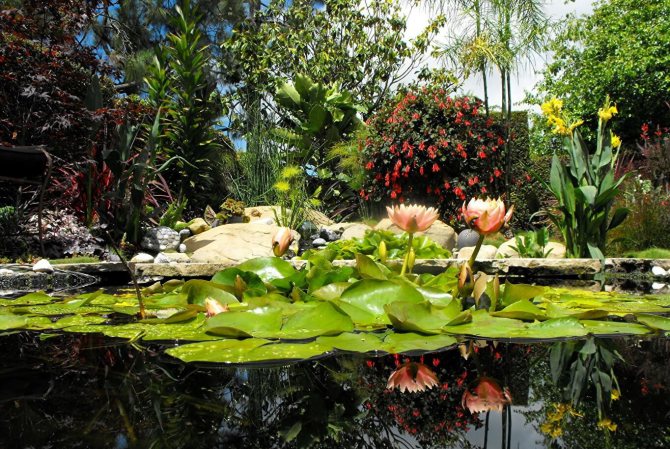

Blossoming of the nymphea begins in spring, revealing large water lilies of white, pink, pale yellow, purple and blue colors.
One of the interesting features of the water lily is its ability to close at night and go under water, restoring the freshness of the flower for a new day. The petals of the flower are very delicate, oval-pointed, cream, red or pink in color. The stamens and pistil are located inside the bud. The size of the flower is about 15-25 cm. The scent of a blooming nymphea covers impressive territories.
When the water lily is pollinated, a fruit appears on the peduncle, in the form of a seed capsule, it reaches full maturity under water, opening there and giving seeds. Water lily seeds first stay on the surface, thanks to a thick slimy secretion, then washed by water, become heavy, sink to the bottom of the reservoir and grow.
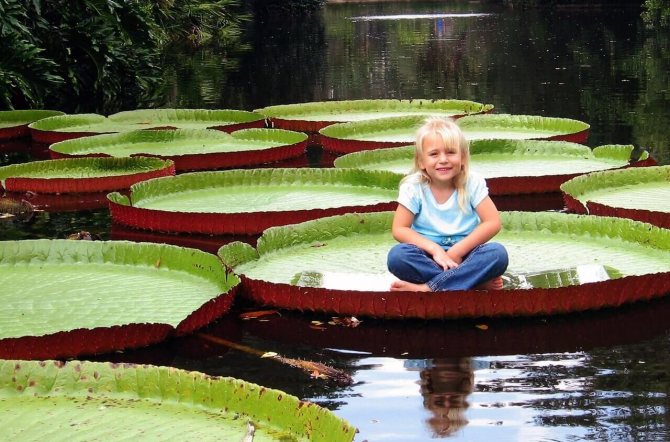

The yellow core of a large flower of the Nile water lily was considered a temporary refuge of the sun god Ra, from the flower he showed the sun to the world. The Egyptians' belief in mystical legends prompted the priests to use the blue lotus in mummification rituals.
When Ramses' sarcophagus was opened, the discovery of the remains of flowers (the mummy was showered with them), which turned out to be water lilies, was evidenced.
Water lilies are of a decorative nature and are highly demanded for decorating artificial reservoirs. Often gardeners think about planting water lilies on the site, but they doubt whether they can create conditions for the growth and development of a flower. Speculation is easily dispelled, thanks to the ability of the water lily to grow even in small (artificial) reservoirs with a suitable temperature and soil.
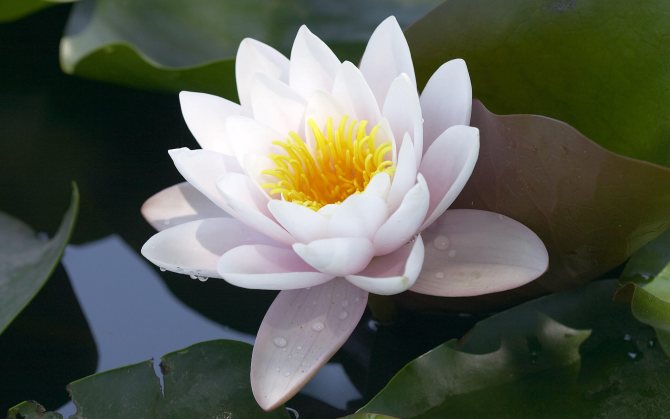

Thanks to its presentable and memorable appearance, the water lily has long won the hearts of true connoisseurs of natural beauty.Florists around the world breed the water lotus as an ornamental crop.
How to collect and prepare a swamp lily flower
The timing of the collection should be set depending on which part of the plant is needed in a given period.
For example, the rhizome is harvested in September. At this moment, it has already nourished a large number of useful trace elements. To get a plant, you need to use hooks, then cuttings and foliage, small roots are peeled. Then they need to be washed, chopped into equal parts and dried at home or outdoors in partial shade.
Water lily flowers should be picked during the flowering period. They are cut before 17:00, and if you just need to pick the buds. This can be done at 7:00 or after 5:00 pm. During this period, the plant sinks into the depths. Flowers are applied fresh. They can also be dried at home in a dark place.
The foliage is harvested at any time in the fall, before frost occurs. You can dry them in a darkened room.
Seeds and fruits can be harvested during the plant's flowering period, which lasts less than a week. The seeds float on the water surface, where they are very easy to collect, and the fruits are lowered into the water slightly deep. The collected parts must be dried.
It is popularly believed that before disturbing the plant, you need to bribe the water spirit by throwing a piece of bread or a coin into the water.
You need to pluck a water lily quite a bit, since the plant is in the Red Book, and its number decreases every year.
Preparing a plant for wintering
A water lily cannot hibernate in shallow water bodies outside, this is true for all cases when freezing reaches the bottom.
Let's figure out a little how to prepare a nymphea for winter. The best place for wintering may be the basement. Storing the nymphea in the basement: just take out the container in which the rhizomes are located and transfer it to the basement, or another dark, cool, but frost-proof place. If you are sure that your reservoir will not freeze to the bottom, then the water lilies can be left to winter in place. This applies to reservoirs with a depth of 0.5 m.
As you understand - water lilies, it is quite easy to grow at home. Create favorable conditions for them and admire the beautiful flowers.
Biological action
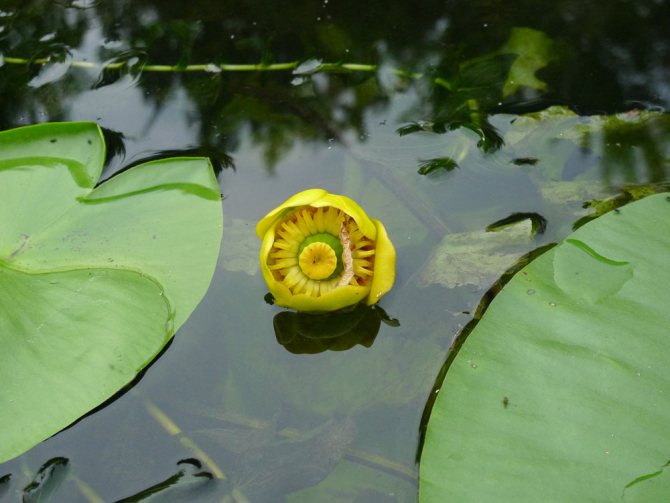

The yellow pod tilted its flower
Alkaloids of plant rhizomes exhibit protistocidal, protistostatic action. Lyutenurin (a mixture of alkaloids hydrochloride) externally acts as a contraceptive. Such drugs are classified as chemical contraceptives, they have spermicidal activity. The medicine is released in the form of vaginal balls and injected into the vagina 10-15 minutes before intercourse. The use of the drug with luthenurin occurs under the supervision of a physician.
Rhizome preparations also treat Trichomonas and urogenital infections.
Medicines with the plant have antimicrobial, antifungal, antibiotic resistance. They are also characterized by bile and diuretic, antispasmodic, analgesic activities. Medicines with a plant are taken with uterine bleeding as a hemostatic, with a decrease in male function, nocturnal emissions (accompanied by pain), peptic ulcer and gastritis.
A well-known preparation of the yellow capsule is Lyutenurin. The drug is available in the form of liniment, suppositories and foaming tablets. The drug is characterized by antimicrobial activity, a wide spectrum of action, suppression of the growth of gram-positive microbes, fungi of the genus Candida, spermatocidal activity. Luthenurin is recommended for people with Trichomonas infections, as well as infections caused by fungi of the genus Candida.
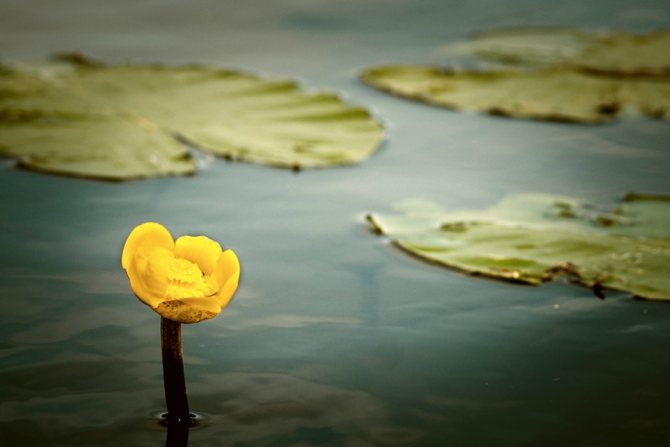

Photo of a lonely egg
For the treatment of Trichomonas diseases, liniment is used intravaginally every day. Suppositories are additionally used. The drug is used in three courses, each lasting 10-20 days. Suppositories and foam tablets are recommended as a contraceptive.They are used according to the instructions 10-15 minutes before the start of intercourse.
When using the drug, irritation and redness from the vagina are possible. If these symptoms appear, you should consult a doctor.
In homeopathy, fresh rhizomes of the yellow capsule are used for sexual weakness, enterocolitis, itching and psoriasis.
Side effects
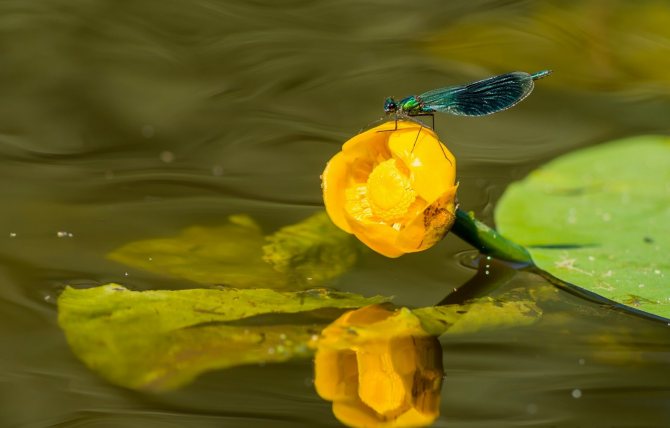

Dragonfly sits on a pod
It is important to know and remember! The yellow capsule is not a safe plant to use. It is poisonous! Its use for medical purposes alone is not recommended. The water lily is used according to the doctor's prescription and under his supervision, in the quantities prescribed in the prescription and the duration of the course. In case of poisoning, disorders of the gastrointestinal tract appear (upset stomach, vomiting).
Marsh lily flower. Different plant names and germination areas
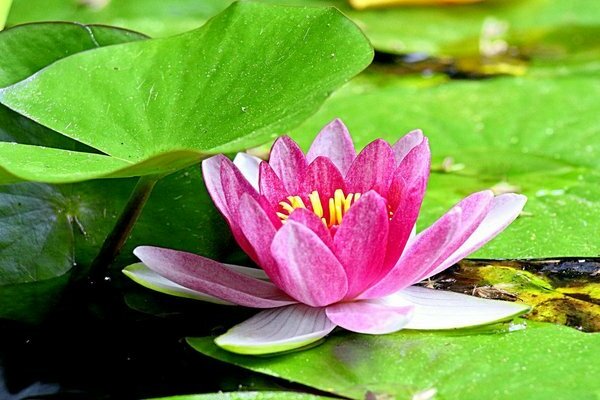

Very often, the water lily is used for medical purposes. The people most often call it: big lapushnik, water poppy, marsh lily, aquarius and so on.
The plant is often found in: Belarus, Ukraine, in the south of Siberia, in the Urals, in the north of the Caucasus. It lives in ponds, river bays and lakes.
The water lily was listed in the Red Book. It is very rarely found in natural conditions, which are getting worse and worse every year.
The plant will grow beautiful and healthy if it receives enough sun. Swamp lily grows well in temperate water and, on the contrary, does not perceive waterfalls and fountains well.
Each varietal feature grows in a specific area of the area. There are times when a plant can spread over a long distance.
It is necessary to estimate the size of the water surface where the plant will be located so that it covers no more than 40% of the total area.
The swamp lily must be planted in a special container, which is then immersed in water to the desired depth. If the plant is small, then it can be lowered by about 10 cm. Therefore, it can be planted in small bodies of water. Water lilies that are actively growing are best planted in a deep reservoir, since the plant will go under water by about 1.5 meters.
Varieties
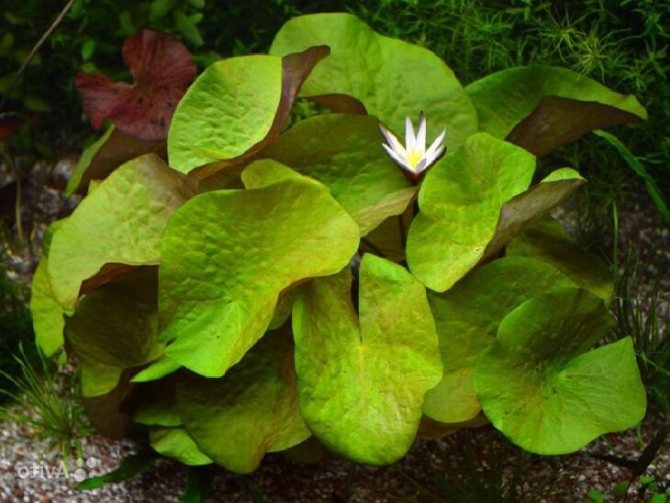

Nymphea rudge
Nymphea rudge. A beautiful form of a plant with round large leaves of a green-pink hue. The number of leaves is formed in accordance with the volume of water in the container. Nymphaea rudge grows too slowly in winter and practically does not form new leaves.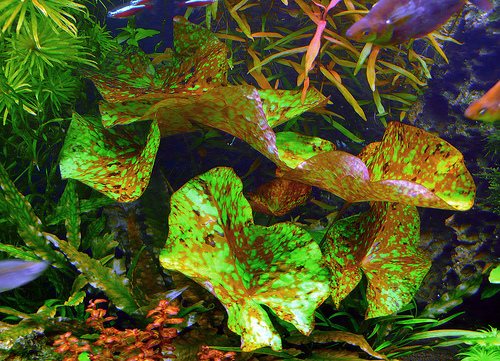

Nymphea Micranta
Nymphaea micranta - differs in the formation of flooded and underwater leaves. The latter are red-green and mottled, and the overflowing leaves are a solid green hue. The water lily makes an excellent decoration for aquariums. In good conditions, the nymphea micranta grows up to 30 cm and more. When the lostus forms emergent leaves, a flower stalk with a beautiful water lily will soon appear, after which the seeds appear.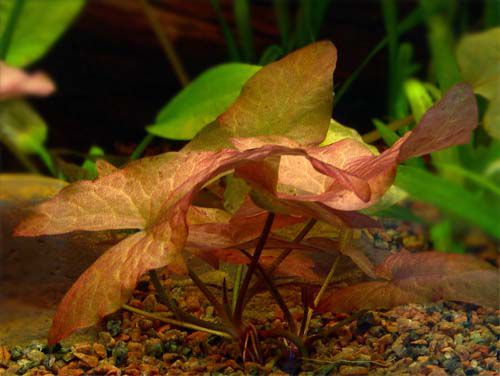

Nymphea stellataNymphaea stellata - differs from other species in the presence of reddish leaves, it is a spreading and demanding plant. Nymphaea stellata requires the formation of high-quality soil for it. Particular attention should be paid to a flower that looks like a real star up to 14 cm in diameter. Nymphaea stellata is characterized by a variety of colors - red, white, blue, gradient with a rich core and light edging.


Viviparous nympheaViviparous nymph is a spectacular plant for an aquarium. The upper part of the leaves is bright green, and the lower part has dark purple and burgundy specks. The gingerbread is unpretentious to the hardness and acidity of water.
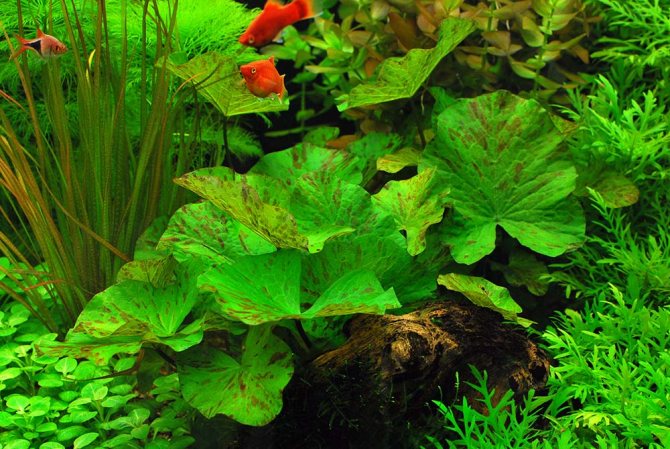

Green tiger nympheaTiger green nymphea is the simplest variety with large green leaves, and blooms a beautiful white flower during flowering.
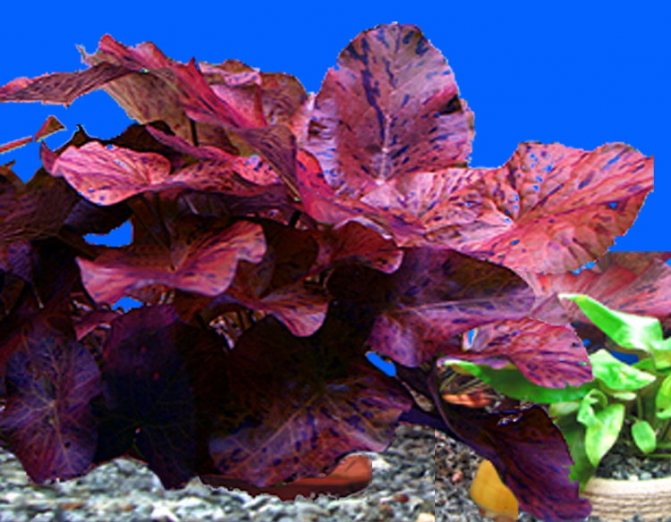

Nymphaea tiger redTiger red nymph - has pronounced bright green or delicate olive leaves, on which a beautiful burgundy pattern is distinguished.
Question number 4: What varieties of water lilies are best to get to get started?
All varieties of lilies are divided into 2 groups by origin and 4 by size.By origin: tropical (Tropical, T), we discard these immediately, if we are not going to grow them in a greenhouse, and winter-hardy, this is just our option.
By size, they are divided into dwarf, small, medium and large. The division is rather arbitrary, theoretically, dwarf varieties grow at a depth of about 25 cm, and large ones require a depth of 50-100 cm. In fact, they all grow well at a depth of 40 to 80 (100 cm). Still, it is better to take into account the size and depth and, if possible, correlate.
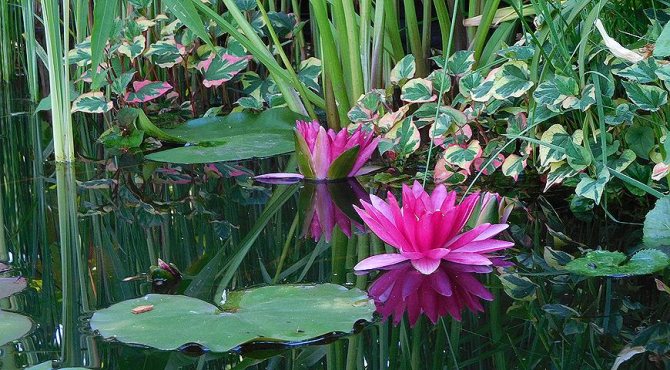

Dwarf nymphs
Not resilient enough to grow in large ponds and are best planted in small warm ponds or containers. Most often sold as the nymphea Pygmaea, i.e. Pygmaea Helvola (light yellow flowers, leaves with brown spots), Pygmaea Alba (white flowers), Pygmaea Rubra (red flowers).
Read more about water containers >>>>
Small and medium nymphs
These varieties are most suitable for growing in the Moscow region and central Russia. The list of varieties is quite extensive, conditionally they can be divided by color:
- white nymphs: Gladstoniana, Laydekeri Alba, Perry's Double White, White Sensation;
- yellow and orange nymphs: Carolina Sunset, Gold Medal, Sulfurea, Paul Hariot, Yellow Princess, Yellow Sensation;
- pink and red nymphs: Burgundy Princes, Fabiola, Firecrest, Laydekeri Purpulata, Lily Pons, Peter Slocum, Red Queen, Rosennymphe, Ruby Red;
- dark red nymphs: Almost Black, Black Princess.
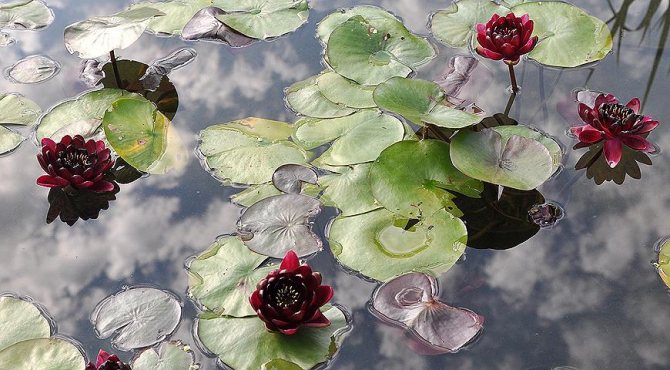

Nymphea Black Princess
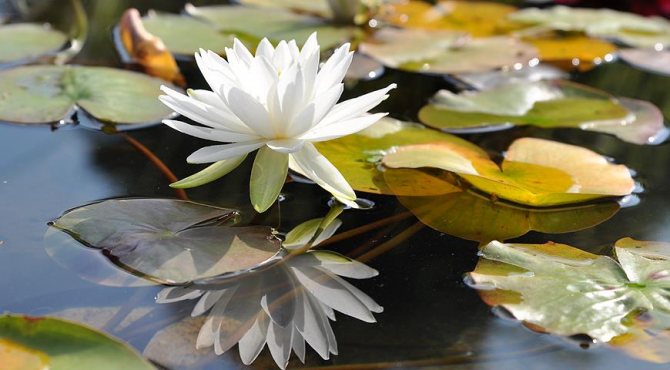

Nymphea White Sensation
Application in traditional medicine
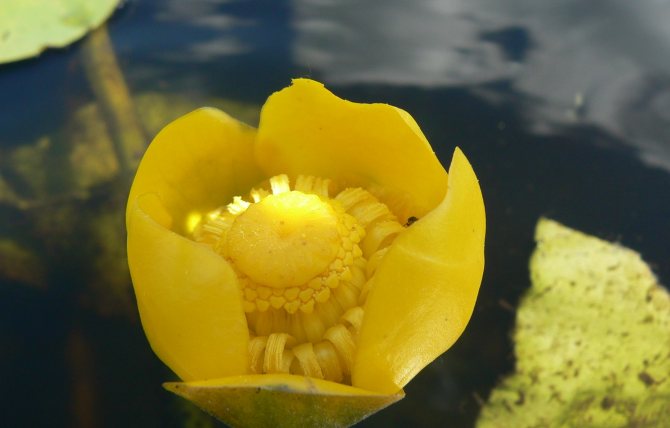

Egg capsule close up
Traditional medicine has long known the yellow capsule due to its beneficial medicinal properties. Consider the recipes and action when using the plant.
- for the treatment of headaches, yellow capsule leaves are used. It is believed that the effect of using the plant occurs after its leaves are dry.
- infusions and decoctions of yellow capsules are used to lower the temperature.
- infusion of flowers is used as a tonic, sedative. For cooking, take: boiling water and flowers in a ratio of 50: 1 (it is better to cook for 1 liter), leave for 60 minutes, filter. Take an infusion of 15 ml (1 tbsp. L.) Two to three times a day.
- a decoction of rhizomes is used for urolithiasis. For cooking, take: boiling water and rhizomes in a ratio of 20: 1 (it is better to cook for 100-200 ml), boil for 20 minutes, insist for 90-120 minutes, filter. The broth is drunk in 20-25 drops two to three times a day.
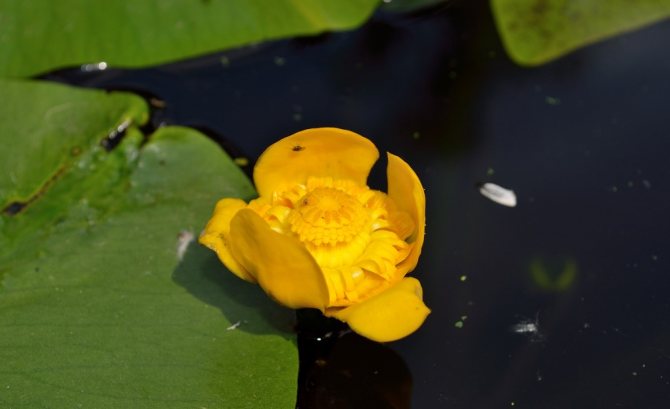

Photo of the egg-capsule
- for tonic baths and washings, a decoction of flowers is used. For cooking, take: boiling water and rhizomes in a ratio of 25: 1 (it is better to cook for 1 liter), boil for 10-15 minutes, insist for 30 minutes.
- for bruises, a compress is recommended. For cooking, take: wrap 50 g of flowers in a gauze cut and place in hot water for 5 minutes. Apply a compress to the site of injury.
The best varieties of water lilies
| Сomanache. Water lily of Latour Marliaka selection, flower diameter 13 - 15 cm, planting depth 20 - 40 cm, coverage area 2.5 - 10.5 sq. M. |
| White 1000 Petals. Water lily of the selection of the nursery Perry Gardens, flower diameter 14 - 16 cm, planting depth 40 - 80 cm, coverage area 10.5 - 18 sq. M. |
| Almost Black. Water lily of the selection of Perry D. Slocum, flower diameter 12 - 15 cm, planting depth 40 - 60 cm, coverage area 10.5 - 18 sq. M. |
| Sulfurea Odorata. Water lily of Latour Marliaka selection, flower diameter 10 cm, planting depth 15 - 50 cm, coverage 2.5 - 10.5 sq. M. |
| Marliacea Rosea. Water lily of Latour Marliaka selection, flower diameter 12 - 15 cm, planting depth 40 - 90 cm, coverage area 10.5 - 18 sq. M. |
Rate the quality of the article. We want to be better for you:
Date of publication: Cultivation
Reproduction
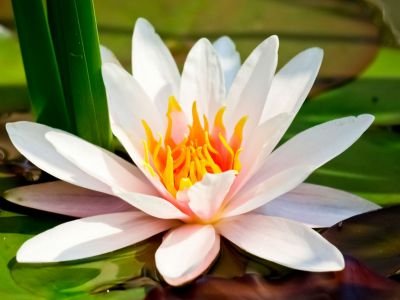

Reproduction is happening seeds and shoots of the root system.
Strongly overgrown powerful bushes must be divided once every 3-6 years.
Excellent for such reproduction fit root system with a well-developed bud.
Slices, which are made with a sharp knife, are sprinkled with crushed charcoal.
Aqua negatively reacts to drying out. Therefore, the bushes necessary transport and place in a new body of water as quickly as possible. Full rooting during vegetative propagation should occur after 14 days.
Medical use
Chemical composition
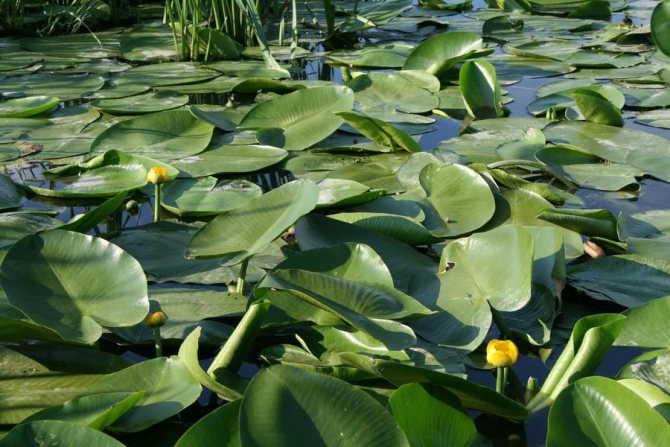

Yellow pods covered the lake
The capsule alkaloids have a unique structure and, in addition to nitrogen, contain heteroatoms of sulfur and oxygen (furan ring). These alkaloids are known as nufaridines, thiobinefaridines. Previously, they were referred to the group of quinolizidine alkaloids, but biogenetically they are of isoprenoid origin.
In the sum of alkaloids, α and β-nufaridines (0.4-0.5%), nufalein, pseudothiobinufaridine, deoxynufarides, and the like were found. The rhizomes of the yellow water lily also contain tannins, sitosterol, stigmasterol, carotene, starch (20%).
Procurement of raw materials
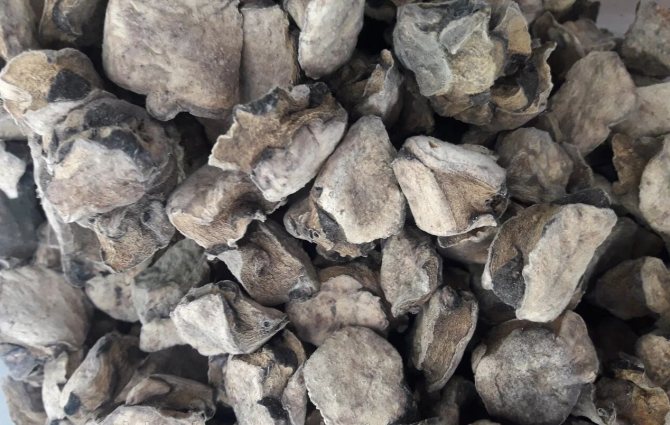

Raw material from the egg capsule
In medical and pharmaceutical practice, the rhizomes of the yellow capsule are used. They are harvested in autumn. Rhizomes are pre-pruned with a knife, and then pulled out of the waters with a pitchfork, rake or hands. Separate leaves, roots, rotten parts. Next, the rhizomes are washed, cut into pieces, laid out in a thin layer. The next stage is dried in the sun and dried under a canopy or in dryers at a temperature of 60 ° C. Yellow water lily - a plant with a not ubiquitous distribution and small reserves of raw materials. Licensed preparation of rhizomes. To restore growth, 15-20% of the plants are left intact.
Yellow egg capsule in other industries
Use on the farm


Yellow capsule
Important! The rhizomes of the yellow capsule are poisonous, so they are not consumed raw. The plant is eaten after boiling in salt water. Due to this, the plant loses properties dangerous to humans and bitter taste, becomes acceptable for food.
Plant rhizomes are prepared in two ways, depending on preference:
Fried
The rhizomes of the capsule are cleaned, washed with cold water, boiled in salted water for 40 minutes. Then they are fried in butter for 20 minutes, consumed warm.
Boiled
The rhizomes are cleaned, washed with cold water, boiled in salted water for 40 minutes. Eat hot or warm with butter.
Rhizome porridge
The rhizomes are cleaned, washed with cold water, passed through a meat grinder for grinding, filled with water for 5 hours. These steps are repeated three more times. Then the water is drained and boiled with spices and salt in water for one hour.
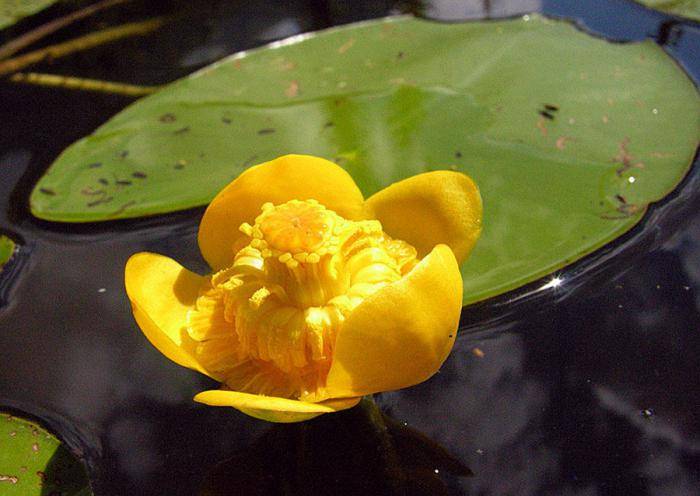

Egg capsule on the water
Also, crushed rhizomes are added to rye flour and cakes, bread, pies, buns are baked. To obtain flour, you should: dry the rhizomes, grind into powder, pour water at the rate of half a bucket of water per one kilogram of flour and leave for two to three hours. The actions are repeated 2 more times, then the resulting flour is laid out in a thin layer and dried.
Animals such as desman, beaver, nutria feed on the yellow capsule, which confirms its role in the animal kingdom.
The fried seeds of the yellow capsule are used to make a drink that resembles the taste of coffee.
Application in cosmetology
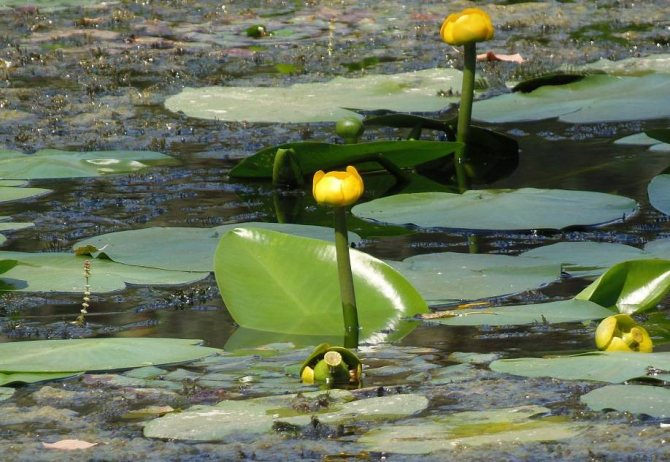

Tall egg-pods
- to strengthen hair, a decoction of rhizomes is recommended. To do this, use beer and rhizomes in a ratio of 25: 1. The plant is added to the beer and boiled for 10 minutes, filtered. Apply 4-6 times a month. Treatment takes two months
- to give the hair strength and lightness, use a decoction of flowers. To do this, pour boiling water over the flowers in a ratio of 25: 1 (it is better to cook for 1 liter), boil for 10 minutes, insist for 30 minutes. Use the broth as a rinse after shampooing your hair.
- for skin rashes, a decoction is used, which is added to the water when taking a bath. For cooking, pour 500 ml of boiling water 2 tablespoons of the flowers of the egg capsule, boil for 20 minutes. Insist in a dark place for 5 hours, filter. The resulting broth is added to warm water while taking a bath.
Bloom
The flowers are single, very large, of a snow-white shade. In diameter, they can reach 15-25 cm. The shape of the flowers is cupped. Each flower has 3-5 petals... By arrangement, the leaves smoothly turn into stamens. The stigma is orange-bloody and depressed.
Scent very strong, delicate, floral. Every flower can bloom 3-5 days... But due to their large number, flowering continues during all warm days from May to September. With the onset of cold weather, the flowers begin to fade. After flowering, oval fruits of an emerald hue are formed. Fruit formation takes place under water.
Chemical composition and distribution
The following substances are present in the composition of the rhizomes and seeds of the nymphea:
- glycoside nymphaline - has a sedative and analgesic effect;
- alkaloid nymphein - has a beneficial effect on the nervous system;
- essential oils;
- tannins, or tannins;
- starch up to 50% in the leaves;
- sugar up to 20%;
- amino acids.
The leaves contain flavonoids, oxalic acid to aid in the absorption of calcium, and tannins. Nymphaea prefers bright sun, shadow interferes with photosynthesis of large leaves. The bud also reacts to light: it blooms at sunrise, and hides under water at sunset. In order for a water lily to take root and grow well, it needs stagnant water or very little current.
Water lily is a typical plant for fresh water bodies of Russia and Europe. Also native to the Middle East and introduced as a crop in China, Australia and New Zealand.
A typical plant for freshwater bodies of Russia and Europe
Diseases that the yellow capsule heals
If we call those diseases that the egg capsule can heal, then these are:
- gastritis;
- uterine bleeding;
- diseases of the central nervous system.


The capsule is used with caution for the treatment of bedwetting in children.
In addition, drugs made from it can be used to correct the performance of the functions of the reproductive system. A particularly positive effect is noted in the case when funds are used to eliminate painful nocturnal emissions, as well as, if necessary, to alleviate the course of impotence and restore lost sex drive. This plant also helps women who want to get rid of such a phenomenon in the female body as frigidity.


The capsule is indicated as a mild hypnotic and sedative
It is worth noting that this plant is used in both folk and classical medicine, so if you see an image of a capsule or a photo of it on the packaging of a medicine, you can safely buy such a medicine, since it is officially approved. For example, as a folk remedy, such drugs can be used to treat stomach cramps, inflammation of the urinary tract and kidneys, rheumatism, tuberculosis. They also cope well with bronchitis, pneumonia, ARVI, gout.


The yellow capsule will help get rid of uterine bleeding
The capsule is used with caution for the treatment of enuresis in children. It is also shown as a mild sleeping pill and sedative. However, it is important to adhere to dosages here, since if they are exceeded, the central nervous system will be inhibited.


You can use the capsule to combat seborrhea
Many recipes for natural medicines involve the use of yellow capsule extracts for pain in joints or bruises, as well as a general tonic. It can also be used for cosmetic purposes to combat seborrhea and enhance hair growth. In any case, you need to get the permission of a doctor, since the egg capsule has a very strong effect, which can in some cases harm the body.


Yellow capsule enhances hair growth
How swamp lily winters
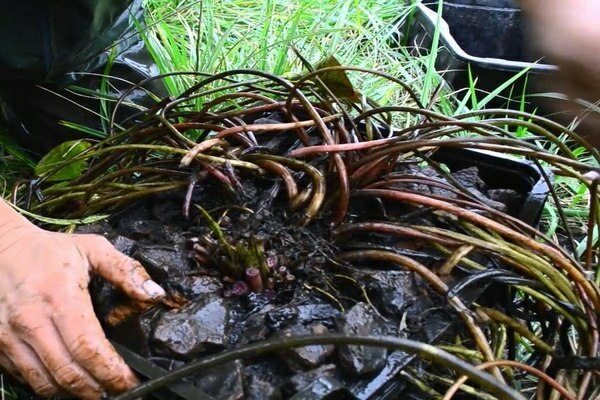

If the main habitat of the water lily is a wide pond, then for the winter the plant can live there. The container with the lily is lowered below the level (at least 50 cm) where the plant can freeze.
In case the reservoir is small or the water is removed from it, then the water lilies are removed in more suitable conditions for wintering.
Containers with water lilies are placed in water and transported to the basement.
All varieties of water lilies have a different relationship to wintering.To begin with, before buying, you need to carefully study this issue, so that later you do not think the day before what to do with the plant.
For example, tropical swamp lilies are very beautiful in appearance, but they are not able to fight the cold. They are able to live in very hot climatic conditions, and tolerate low water, but they will not be able to survive cold temperatures. It is best to transport these plants to the home, where they are placed in a container with a small amount of water.

